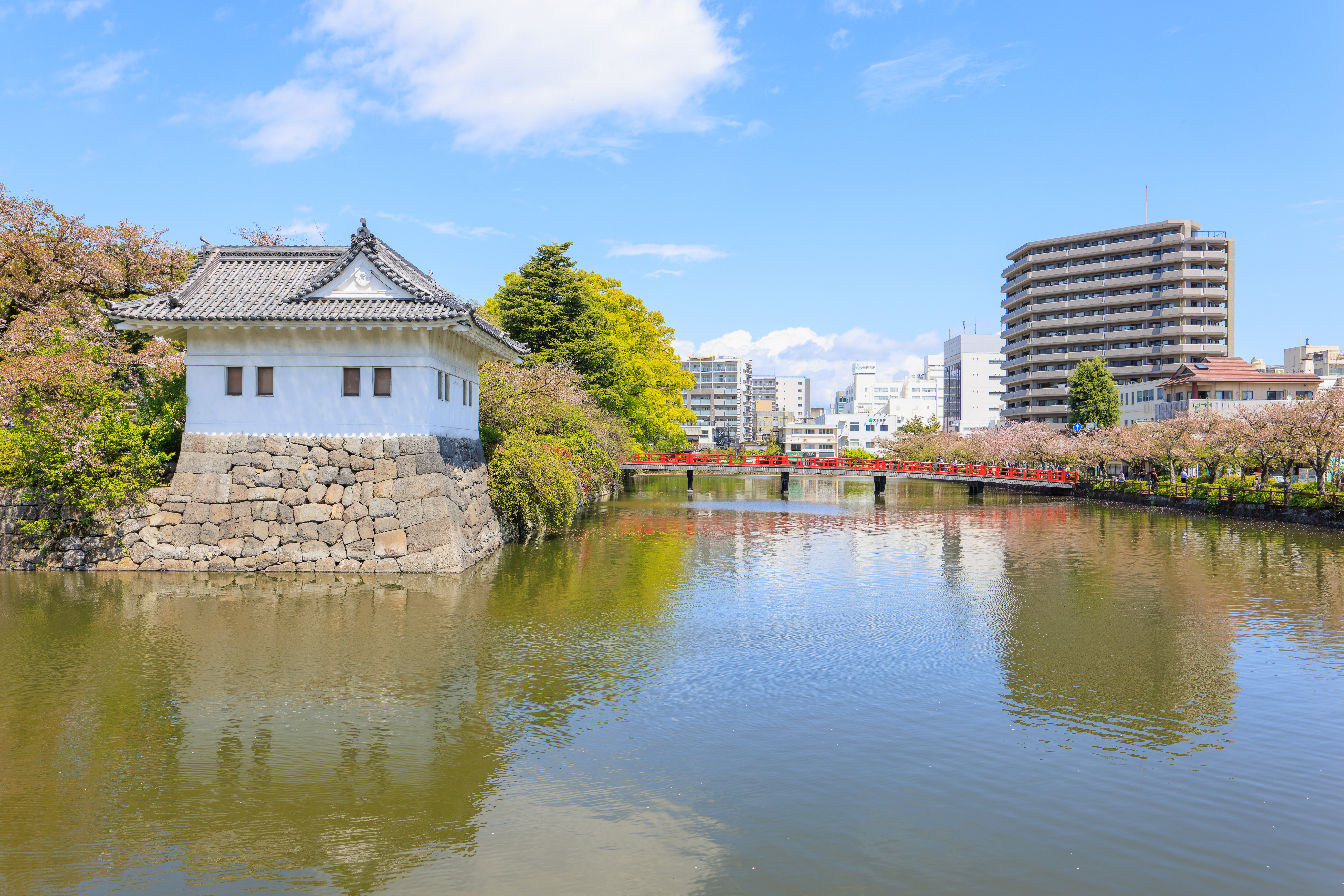After breakfast at the Indigo Gora, we checked out after a fantastic stay and took the hotel’s shuttle bus back to Odawara Station. We spent a few hours in town, primarily visiting Odawara Castle. We then began the journey home, taking the Shinkansen back to Tokyo for our flight out of Haneda.
Morning
After enjoying one final soak in our in-room onsen at the Indigo, we headed downstairs for our usual buffet breakfast.
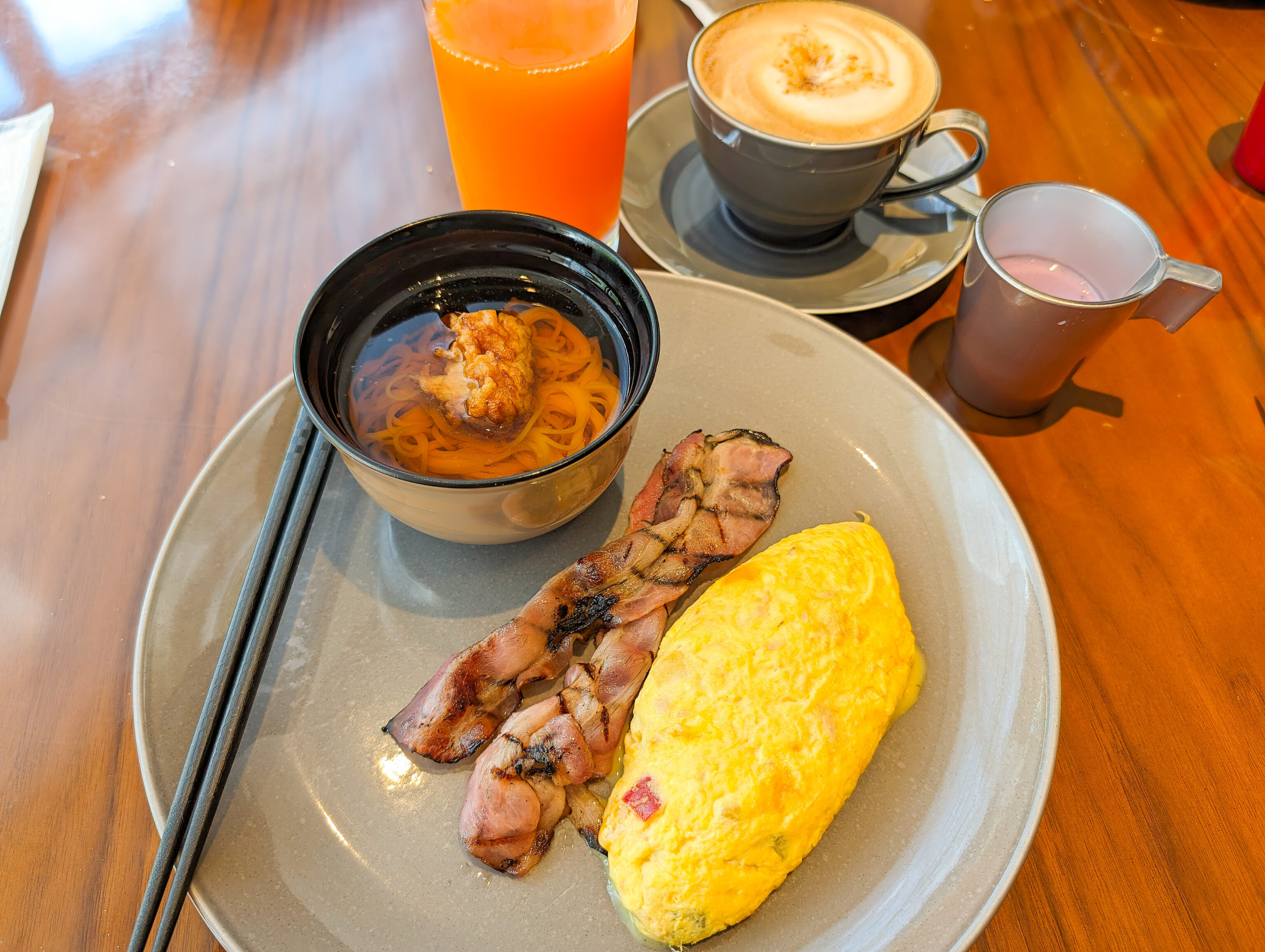
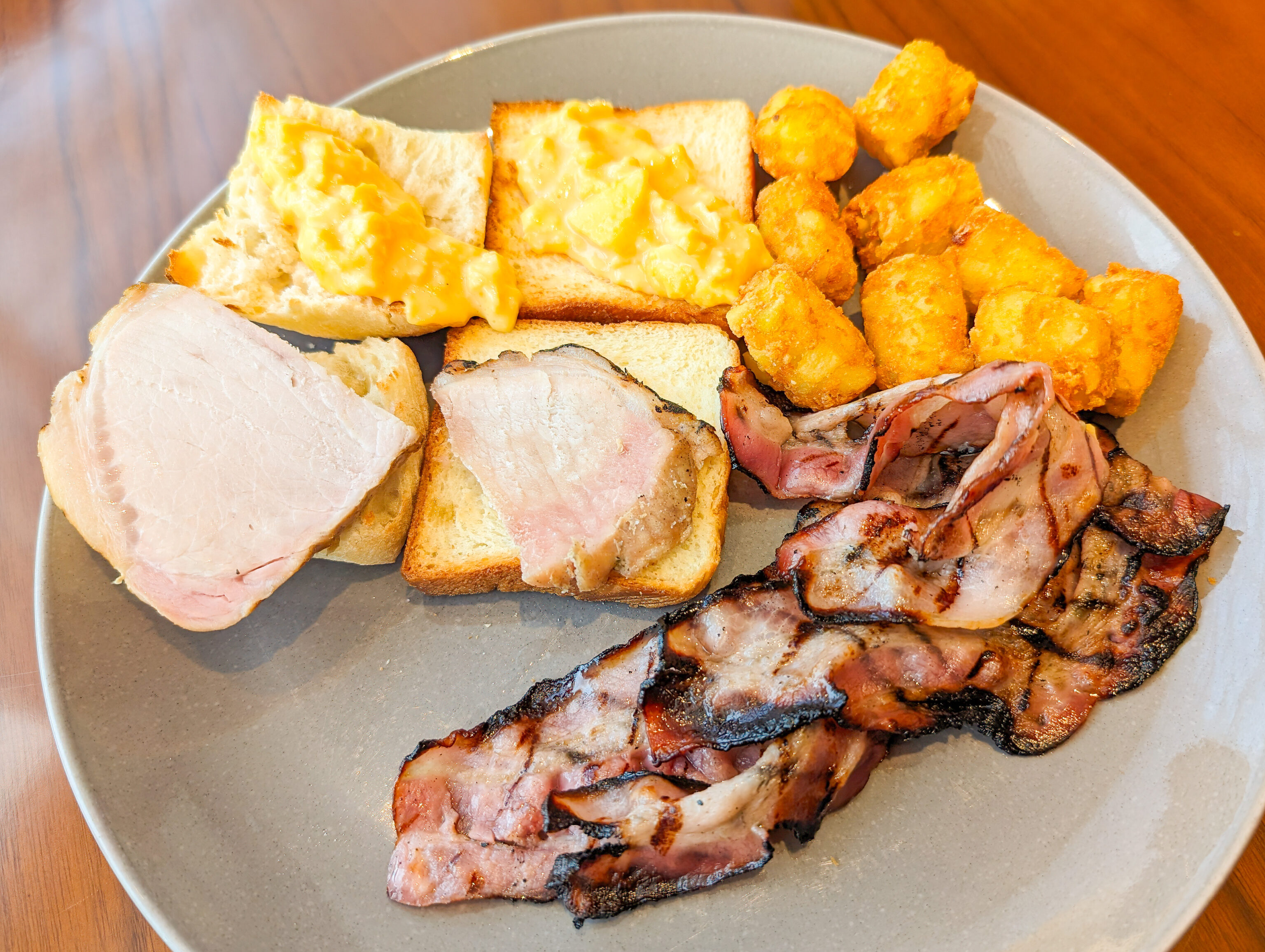
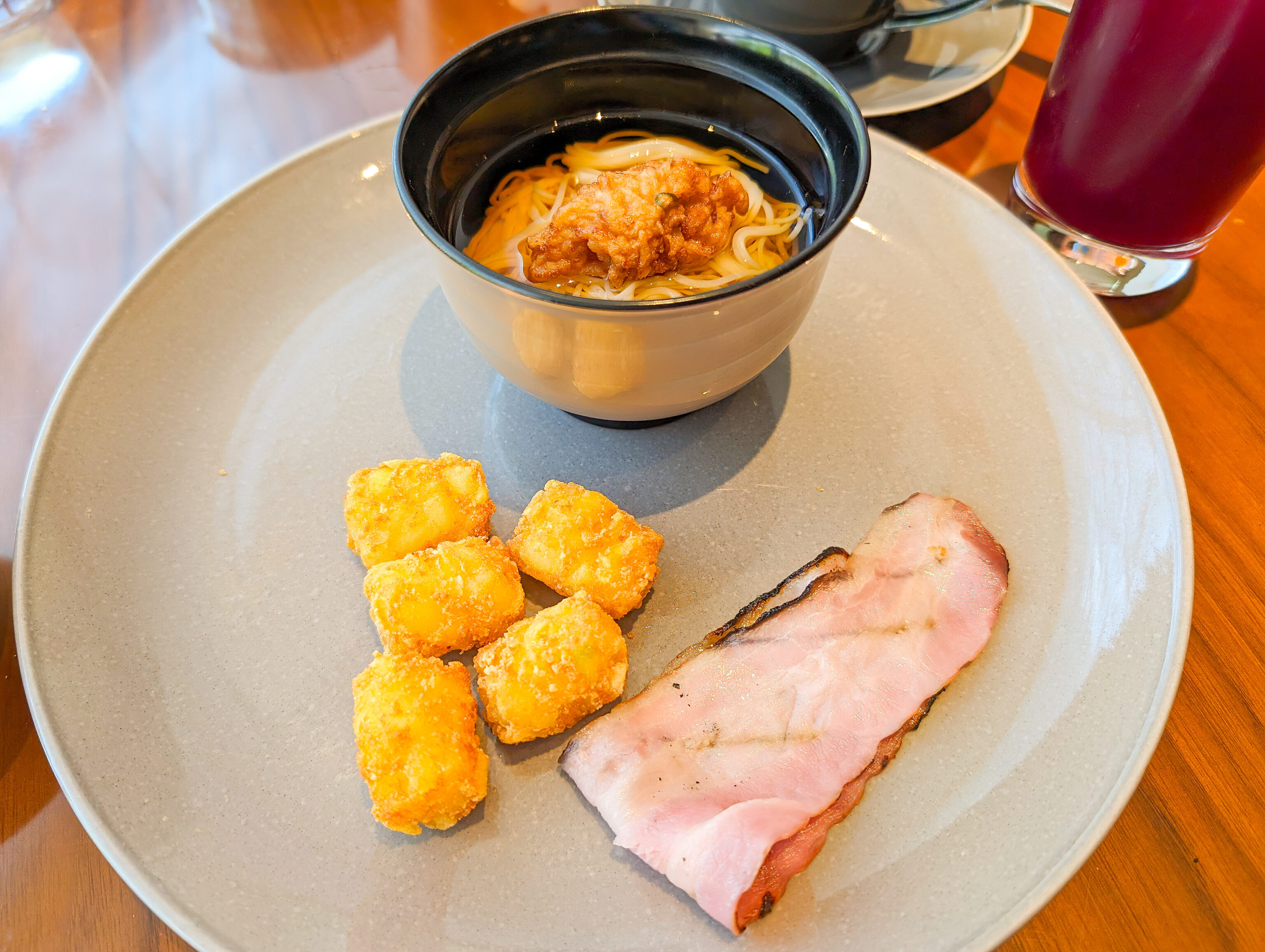
The breakfast is, more or less, the same each day. But there is enough variety that we’ve enjoyed it each of three mornings that we’ve spent here!
Overall, the Hotel Indigo Hakone Gora was fantastic! Our upgraded room was excellent, with the best feature being the in-room but still exposed to the outdoors onsen! We definitely made use of it as much as possible!
We departed on the 9am shuttle to 小田原駅 Odawara Station. The shuttle turned out to be a full sized coach bus. It wasn’t very busy compared to the total capacity of the bus.
Odawara
The ride to Odawara was pretty quick, taking around 40 minutes, including a very brief stop to drop off some passengers who got on the wrong bus, thinking we were going to Gora Station!
Our original plan was to immediately take the Shinkansen back to Tokyo. However, we decided to change our tickets to spend some time here in Odawara before moving on.
After arriving, we dropped off our backs in a coin locker and walked out of the station to visit Odawara Castle.
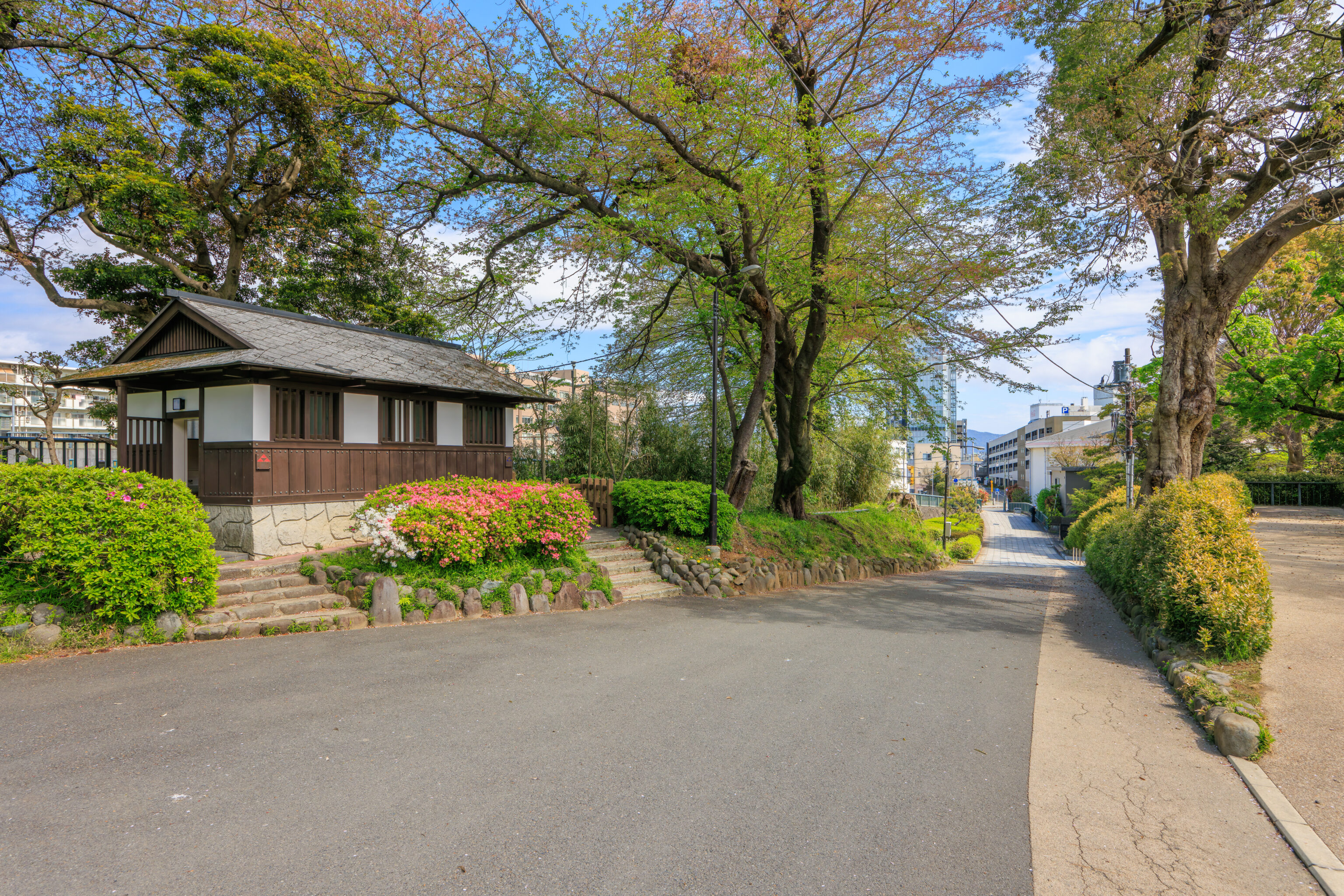
We arrived on the castle grounds via its northern entrance. This was the view looking back after we had walked 100 feet or so. This is something of a rear entrance and not well signed as a way to get in.
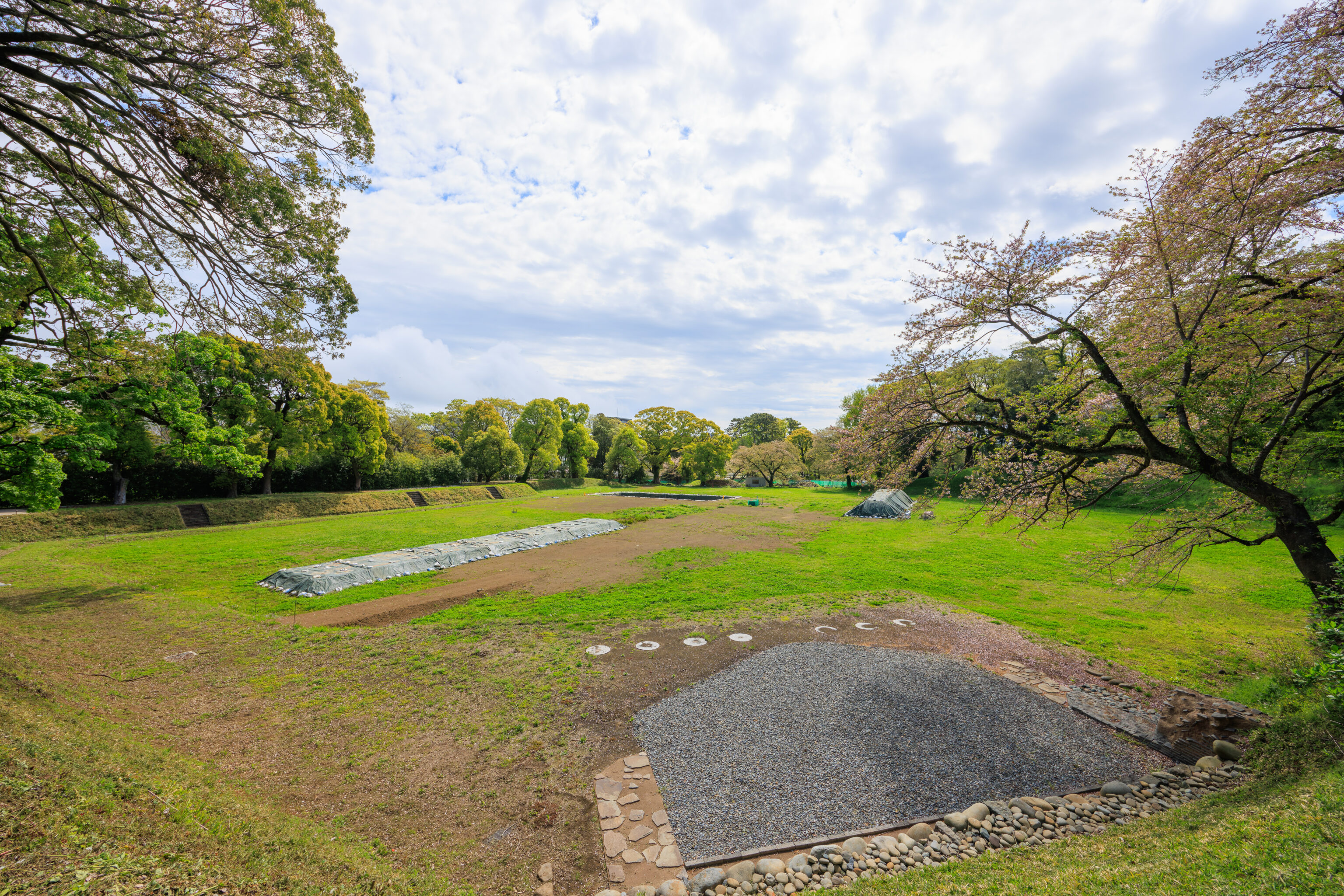
The first thing we saw was this field to our left. A helpful sign explained what we were looking at:
This bailey (courtyard) held extremely important storehouses that stockpiled food, particularly the rice which was paid as tax from territories of the Edo Shogunate. Storehouses were typically 29.5m long and 5.9m wide. A total of six storehouses have been found on top of the earthen walls and on the ground at this site. Other than rice, they were used to store, soybeans, azuki (red beans), arame (Eisenia bicyclis), salt, and armor as well.
Recent excavations have revealed some roof tiles featuring the family crest of the Tokugawa shogunate (Mitsuba Aoi Mon - three mallow leaves). The plaster door of the storehouse is on exhibit inside the castle keep (donjon) gallery.
Interestingly, the sign uses the French word donjon to refer to the keep. This French term has ended up in modern English to be dungeon, referring to a castle prison. We learned this during our visit to Paris last year.
A second sign provided some additional details:
An enclosed space made by a wall of tiles and earth from the Edo period was excavated from this place. The space was surrounded by stone walls, tiled walls and fences. This space was about 10 meters square, and the floor was covered with pebble. The tiled walk was made by laying stones on the bottom and stacking flat roof tiles over 1.5 meters high, and the wall was built after 1703. However, pictorial maps or historical documents showing the usage of this space do not exist, the structure suggests it may have been a religious place or a gunpowder storehouse.
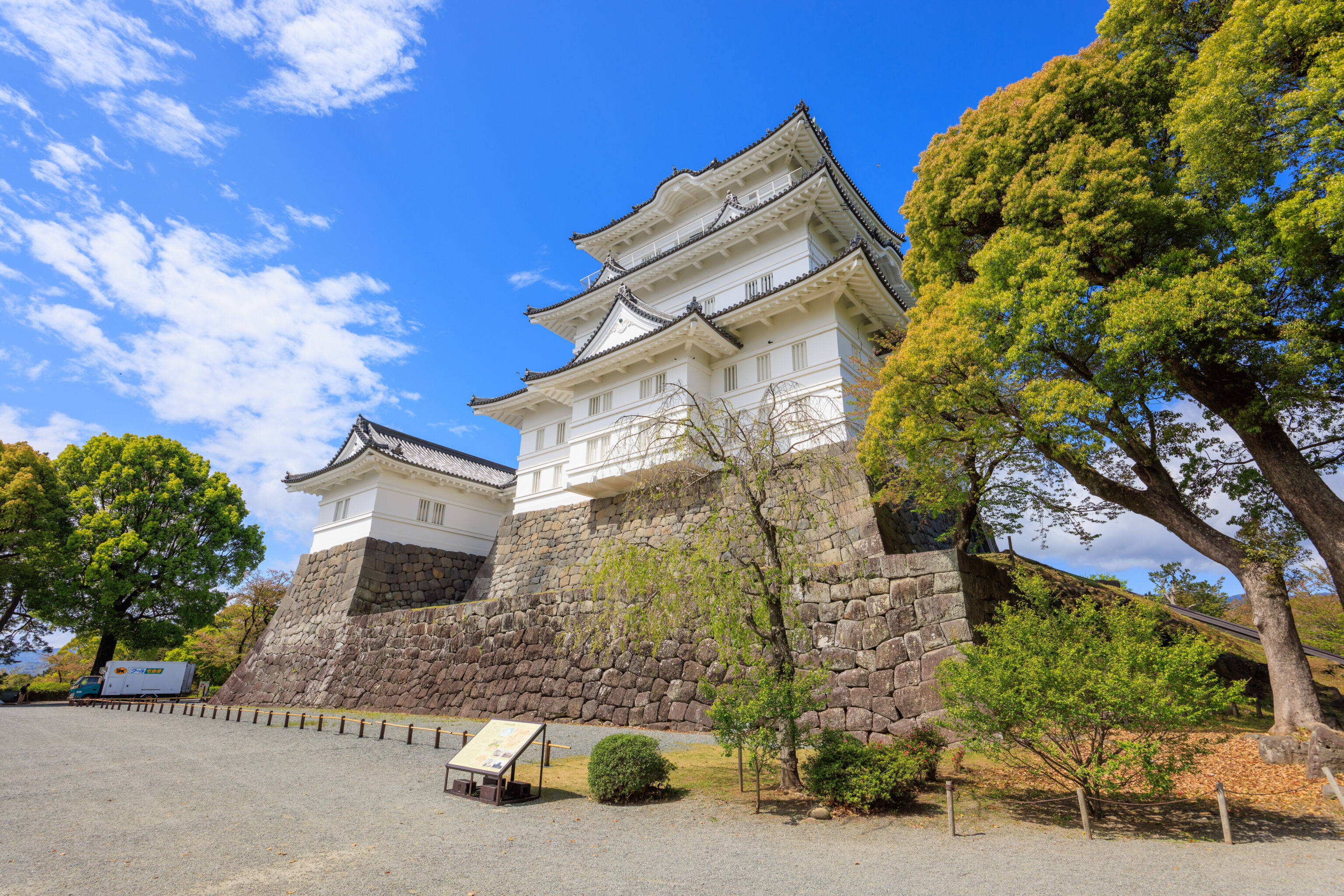
We kept on going to reach the actual castle keep. The castle, like most in modern Japan, is a reconstruction. It was built in 1960. The sign visible here provides a bit of information in English:
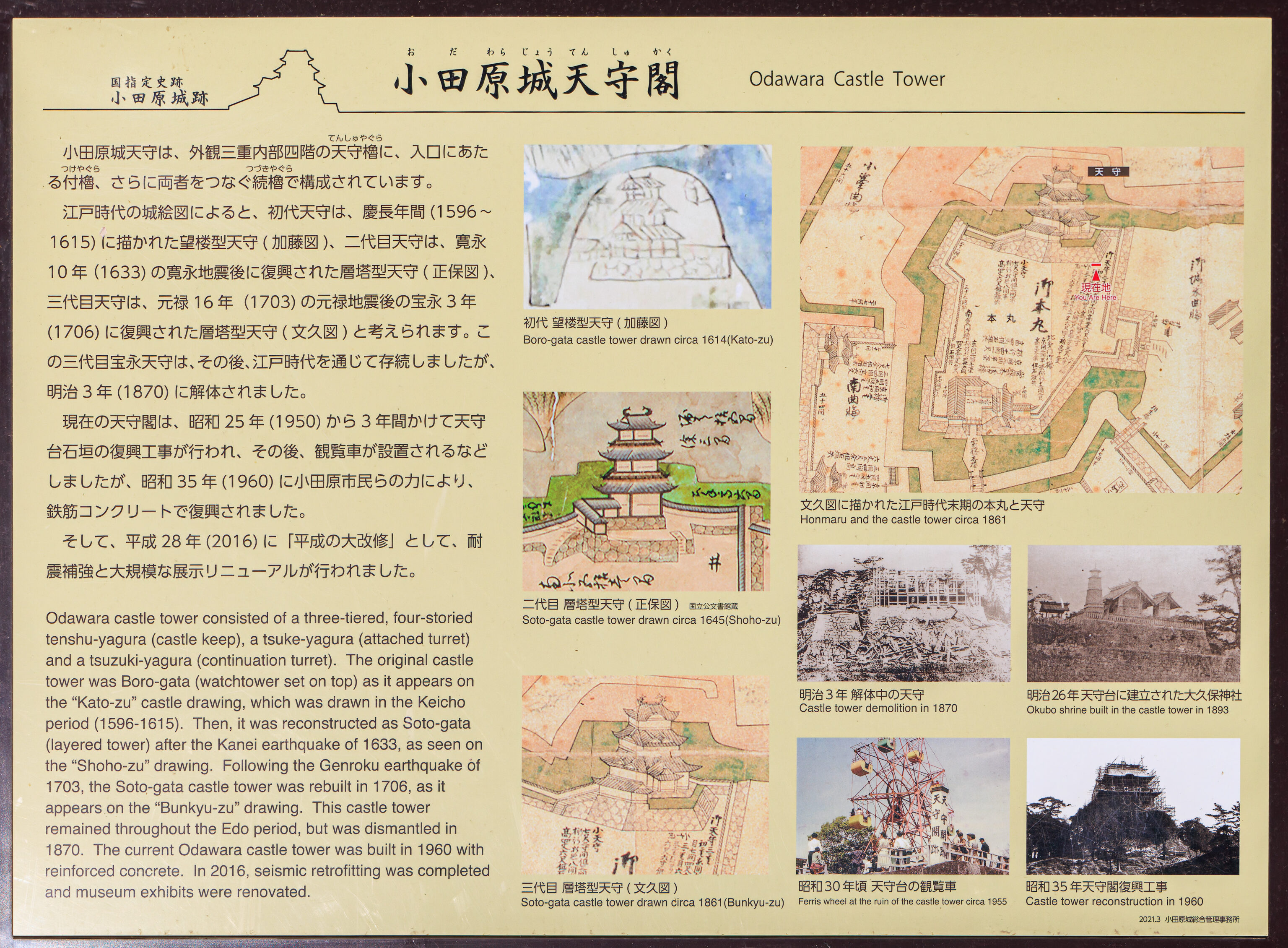
Odawara castle tower consisted of a three-tiered, four-storied tenshu-yagura (castle keep), a tsuke-yagura (attached turret) and a tsuzuki-yagura (continuation turret). The original castle tower was Boro-gata (watchtower set on top) as it appears on the "Kato-zu" castle drawing, which was drawn in the Keicho period (1596-1615). Then, it was reconstructed as Soto-gata (layered tower) after the Kanei earthquake of 1633, as seen on the "Shoho-zu" drawing. Following the Genroku earthquake of 1703, the Soto-gata castle tower was rebuilt in 1706, as it appears on the "Bunkyu-zu" drawing. This castle tower remained throughout the Edo period, but was dismantled in 1870. The current Odawara castle tower was built in 1960 with reinforced concrete. In 2016, seismic retrofitting was completed and museum exhibits were renovated.
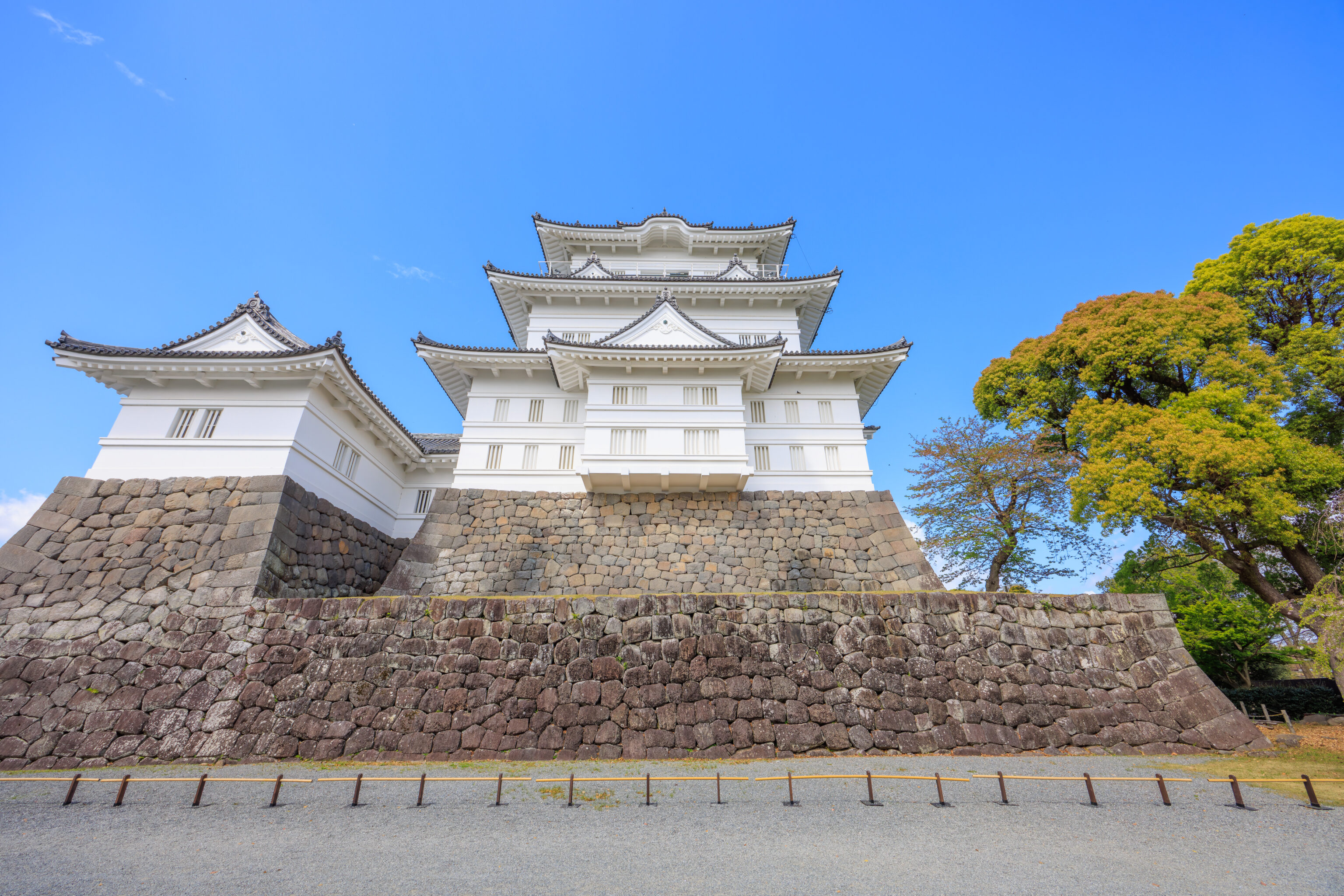
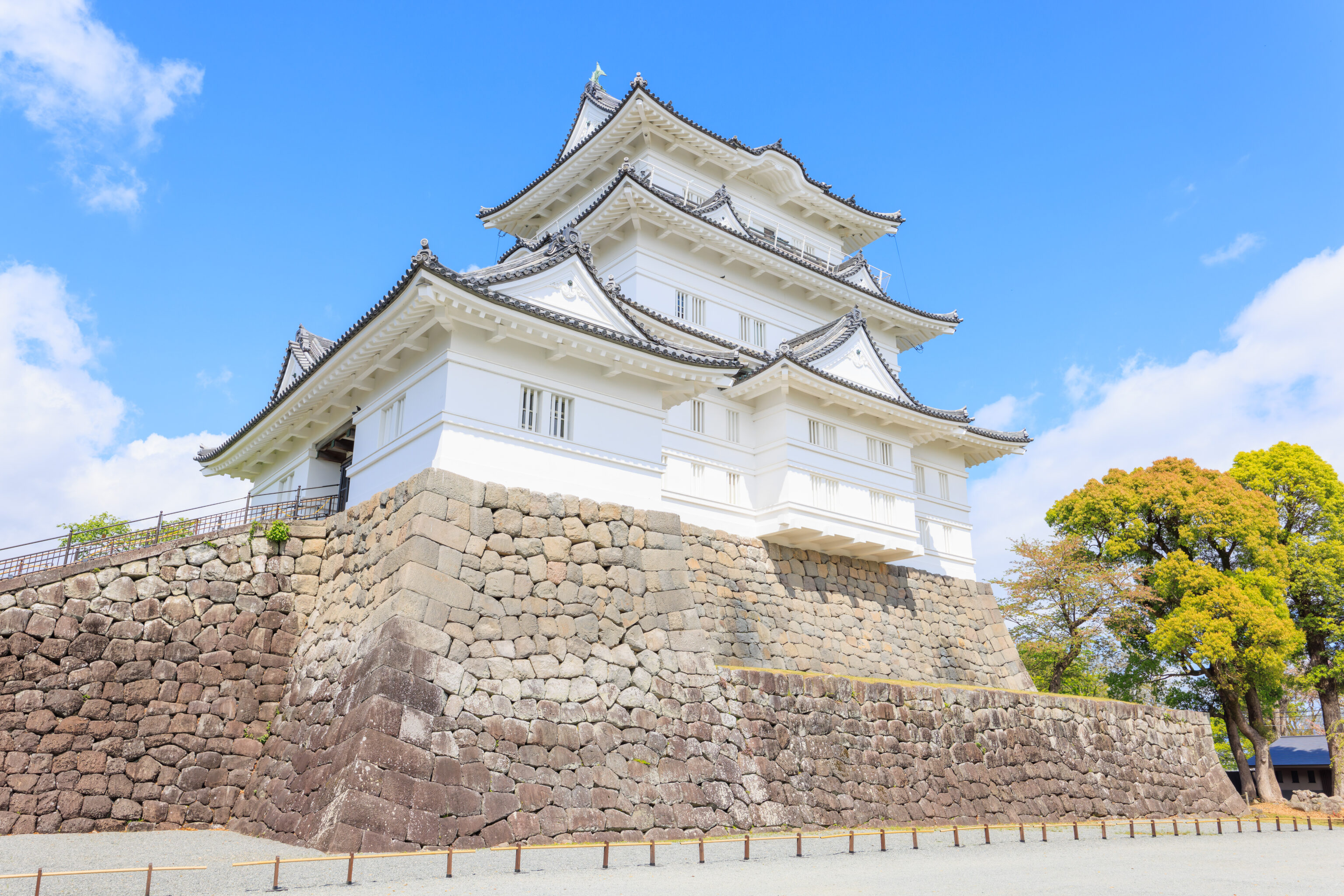
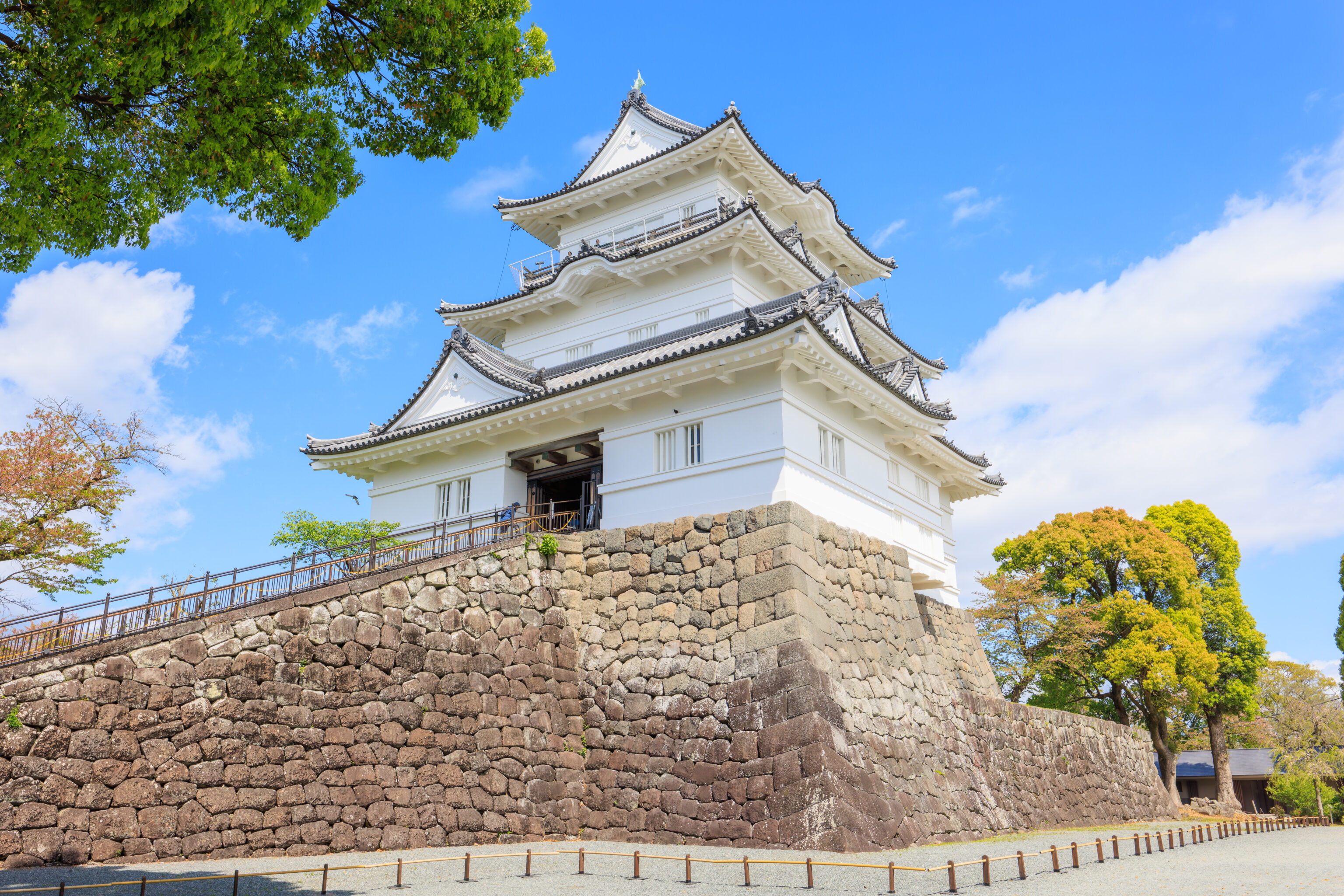
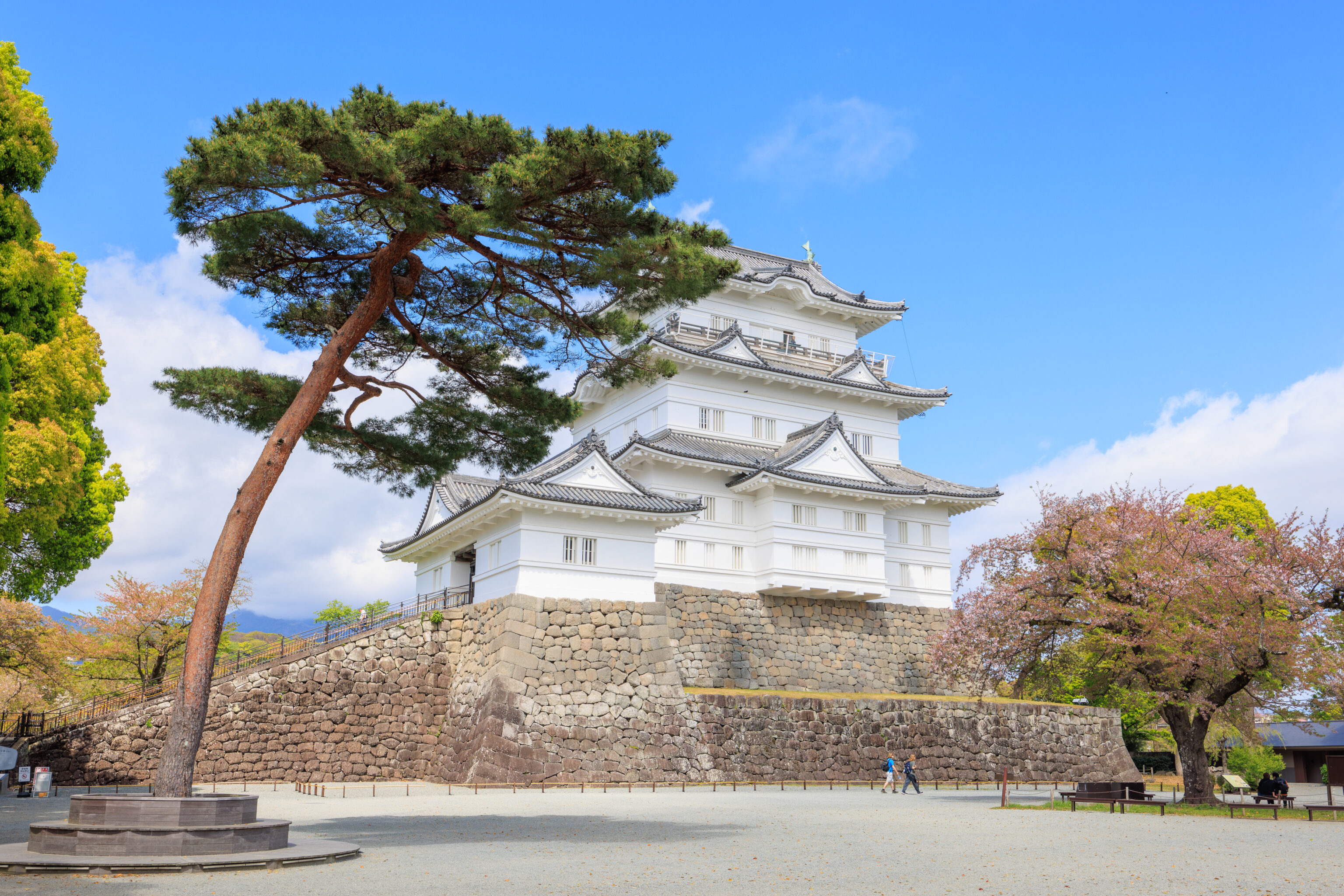
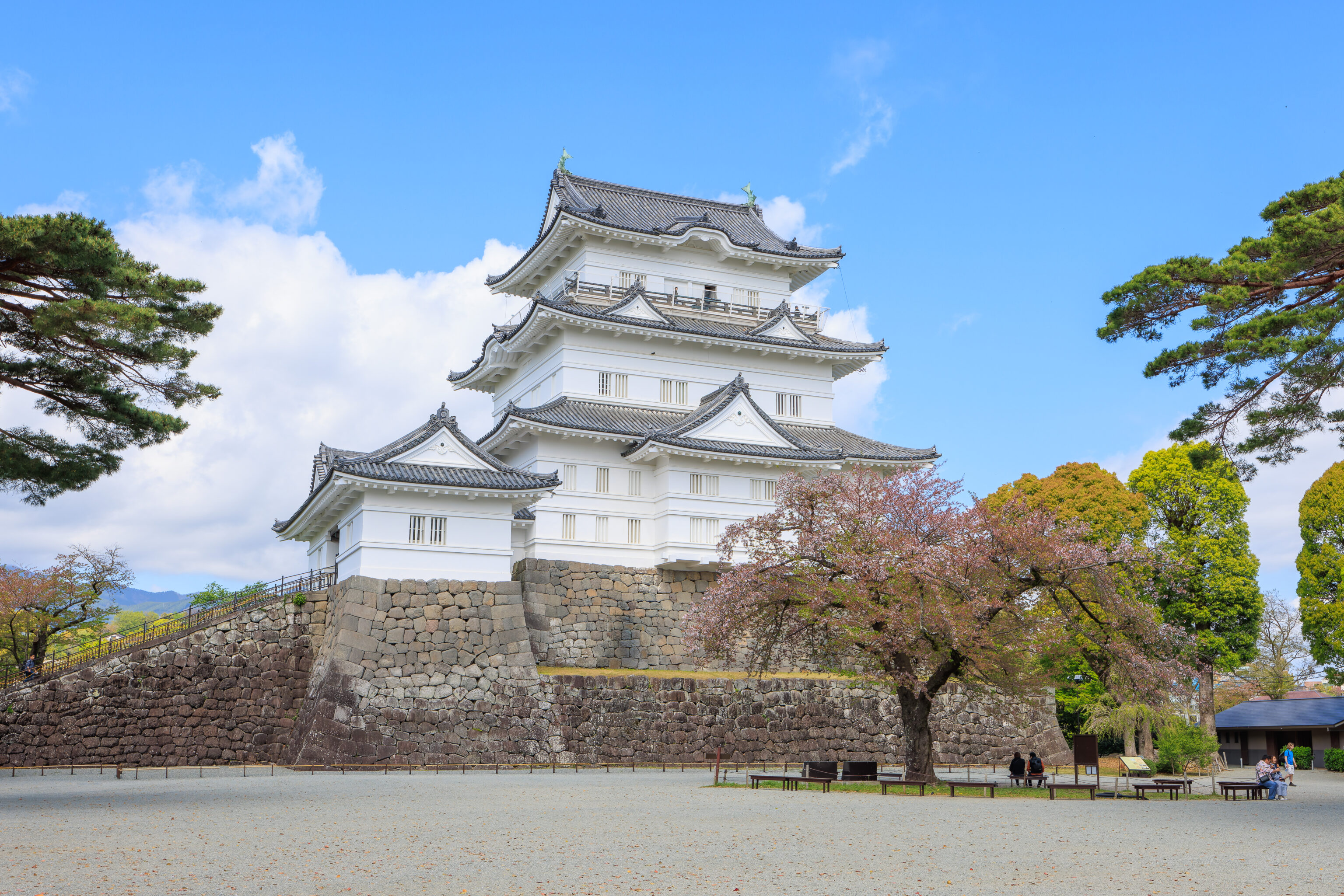
We didn’t enter the castle as we’ve been in reconstructed castles before but did enjoy the view from the 本丸広場 Honmaru Square in front of the building.
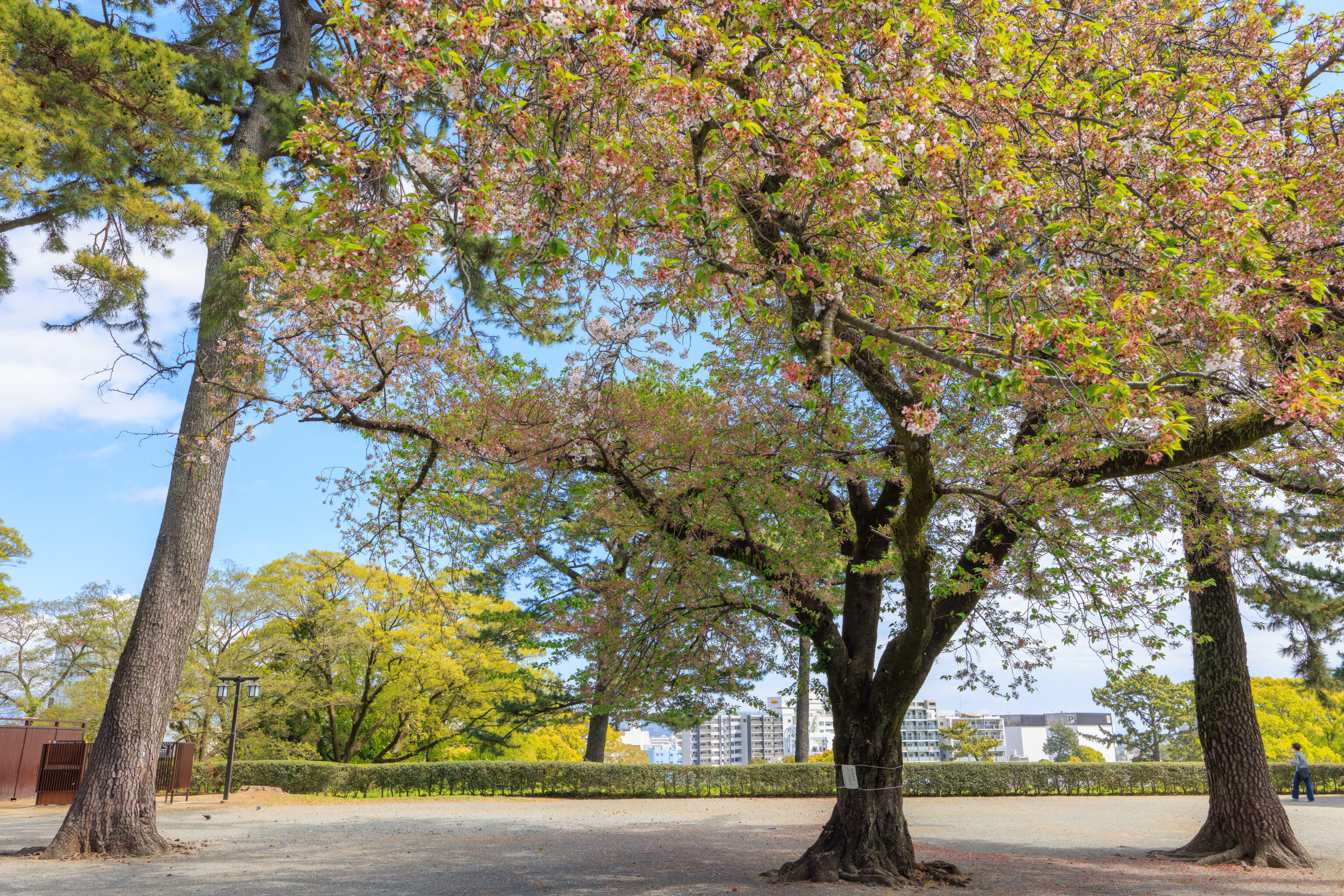
There were many large trees near the castle. This was a sakura with most of its petals having fallen already, as expected given our location. The small piece of paper attached to the trunk reads:
Standard Cherry Tree
This cherry blossom is located in Odawara Castle Ruins Park.
Standard tree for cherry blossoms (Somei Yoshino).
Odawara Castle General Management Office
This seems to imply that this is the indicator tree for determining when peak bloom has occurred.
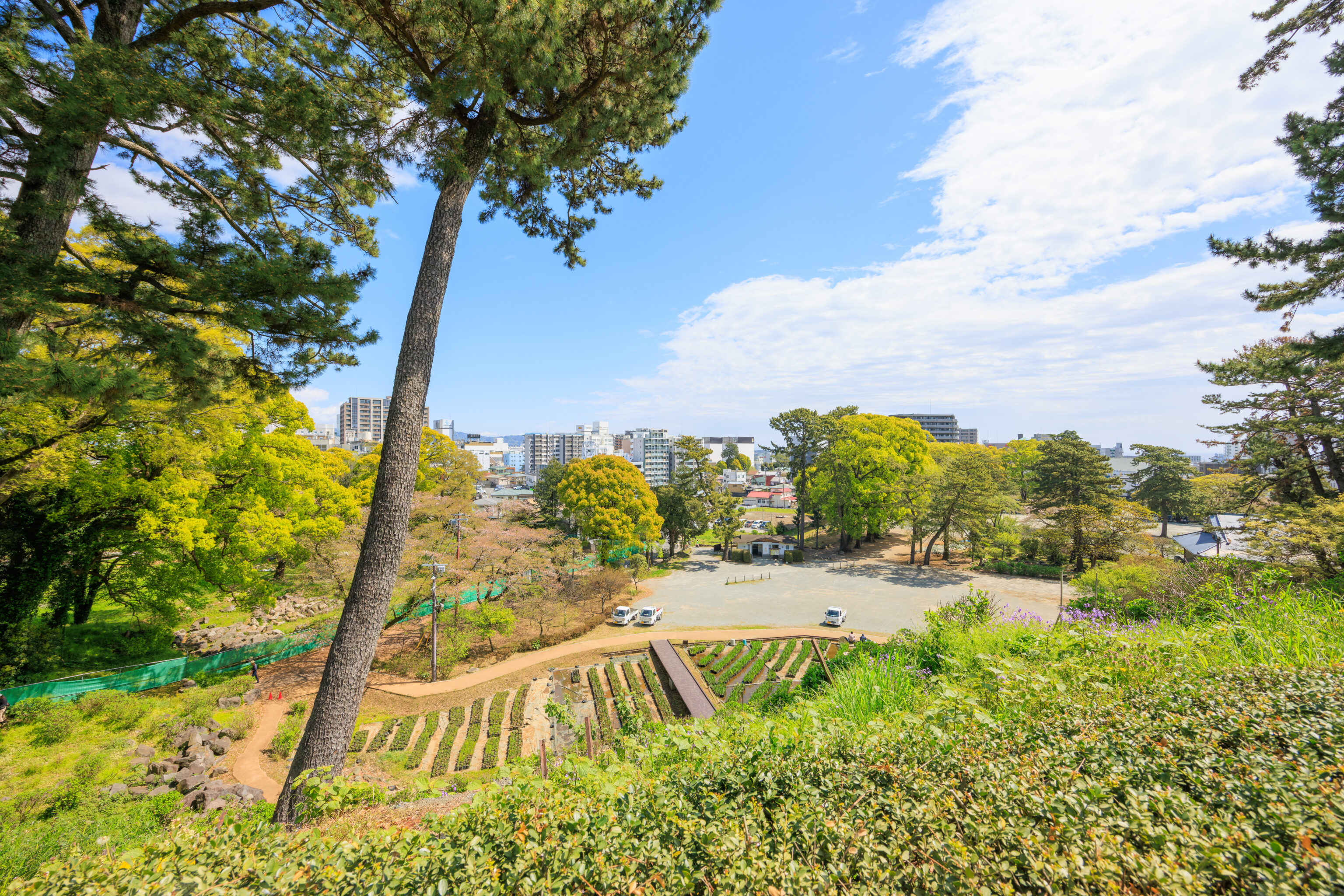
As we had arrived from a rear entrance, we didn’t really see much of the land surrounding the castle. We saw some small fields below to the northeast, along with some nearly petal-less sakura.
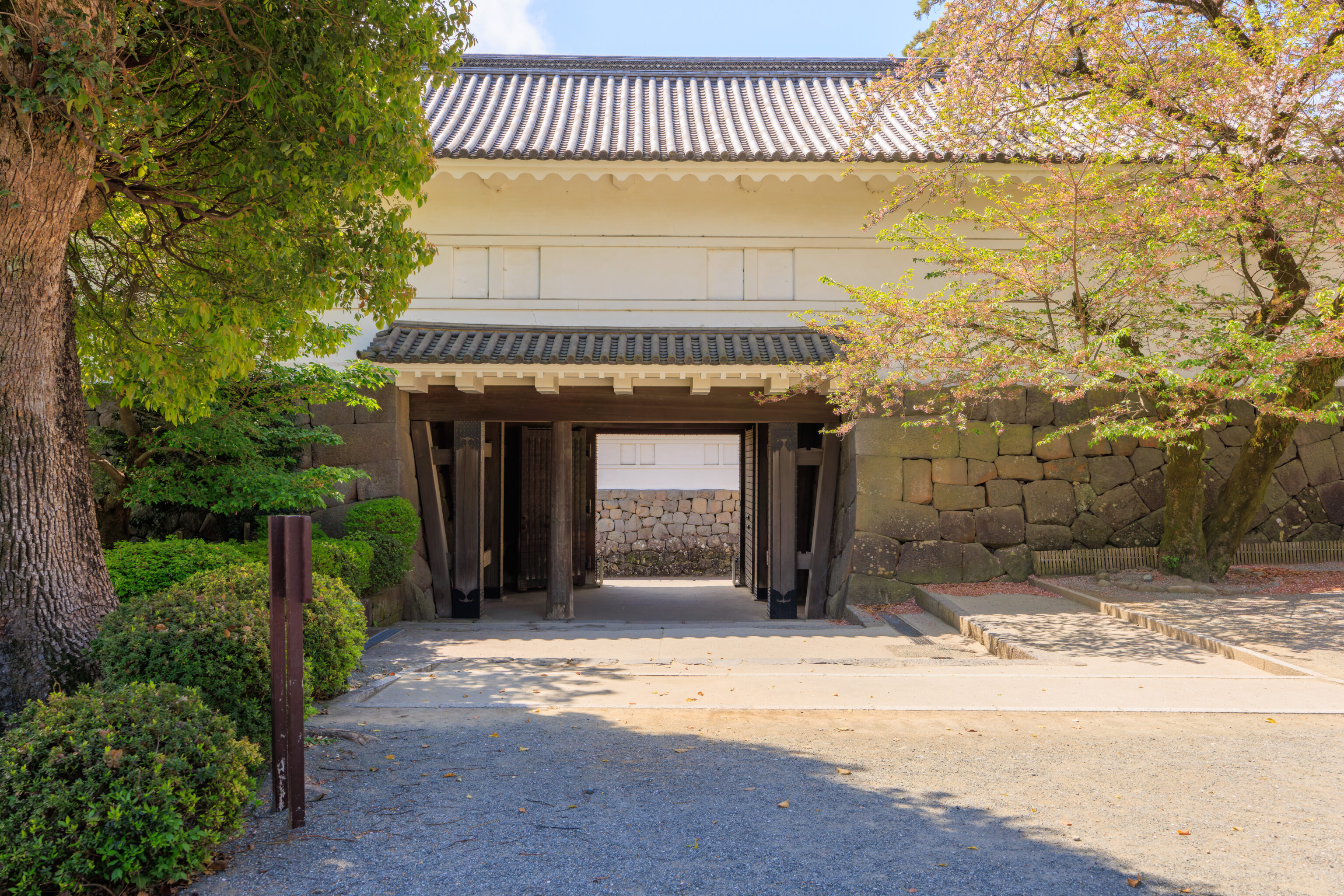
This gate seems to be the primary entrance to the area around the castle keep. We didn’t go this way though! We decided to backtrack and circle around the western side of the keep.
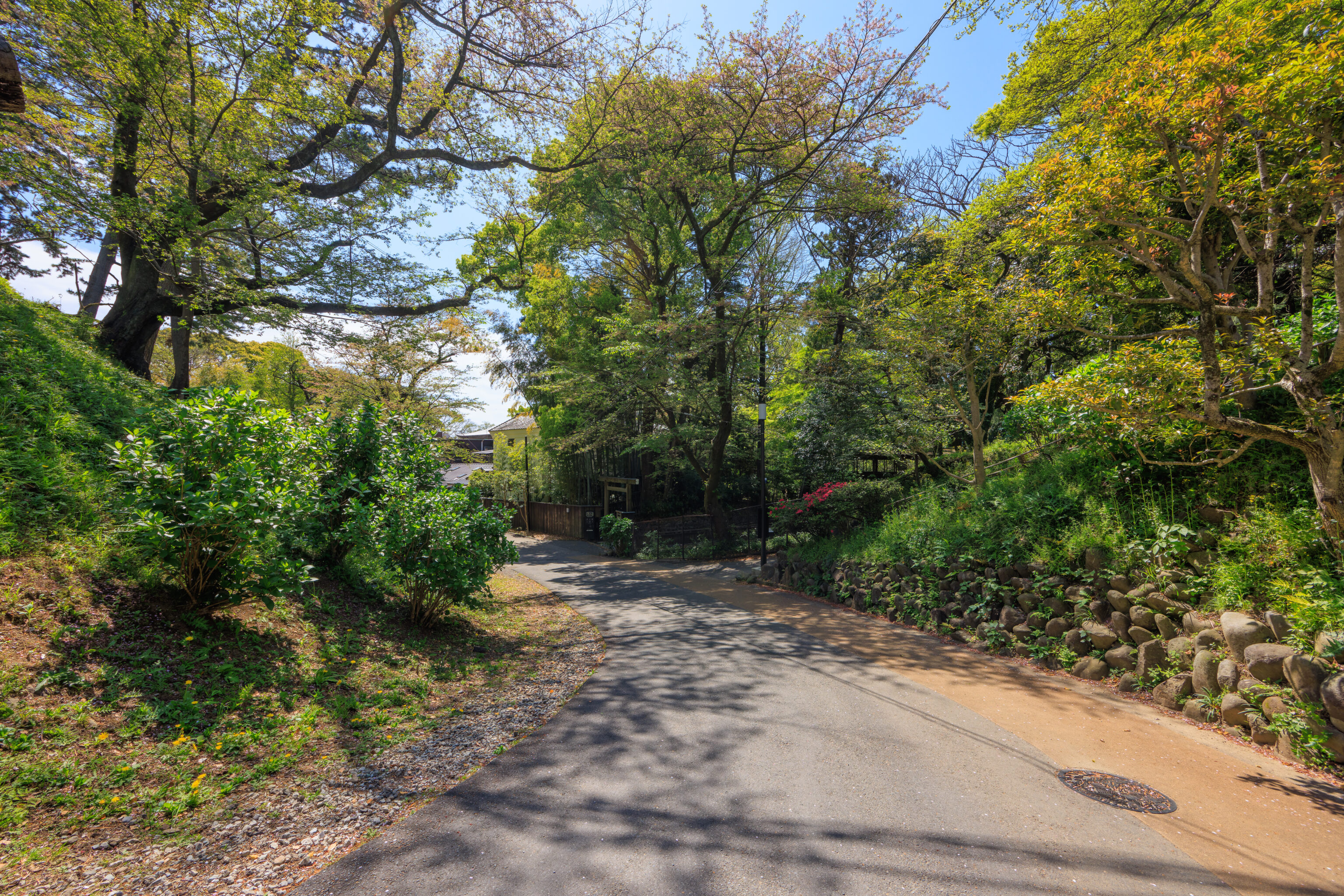
There wasn’t really anything of interest to the west for tourists. We did pass by a small amusement park for children which included a miniature train as well as go-karts. It didn’t seem to be open at the time though. Maybe we should have photographed it?
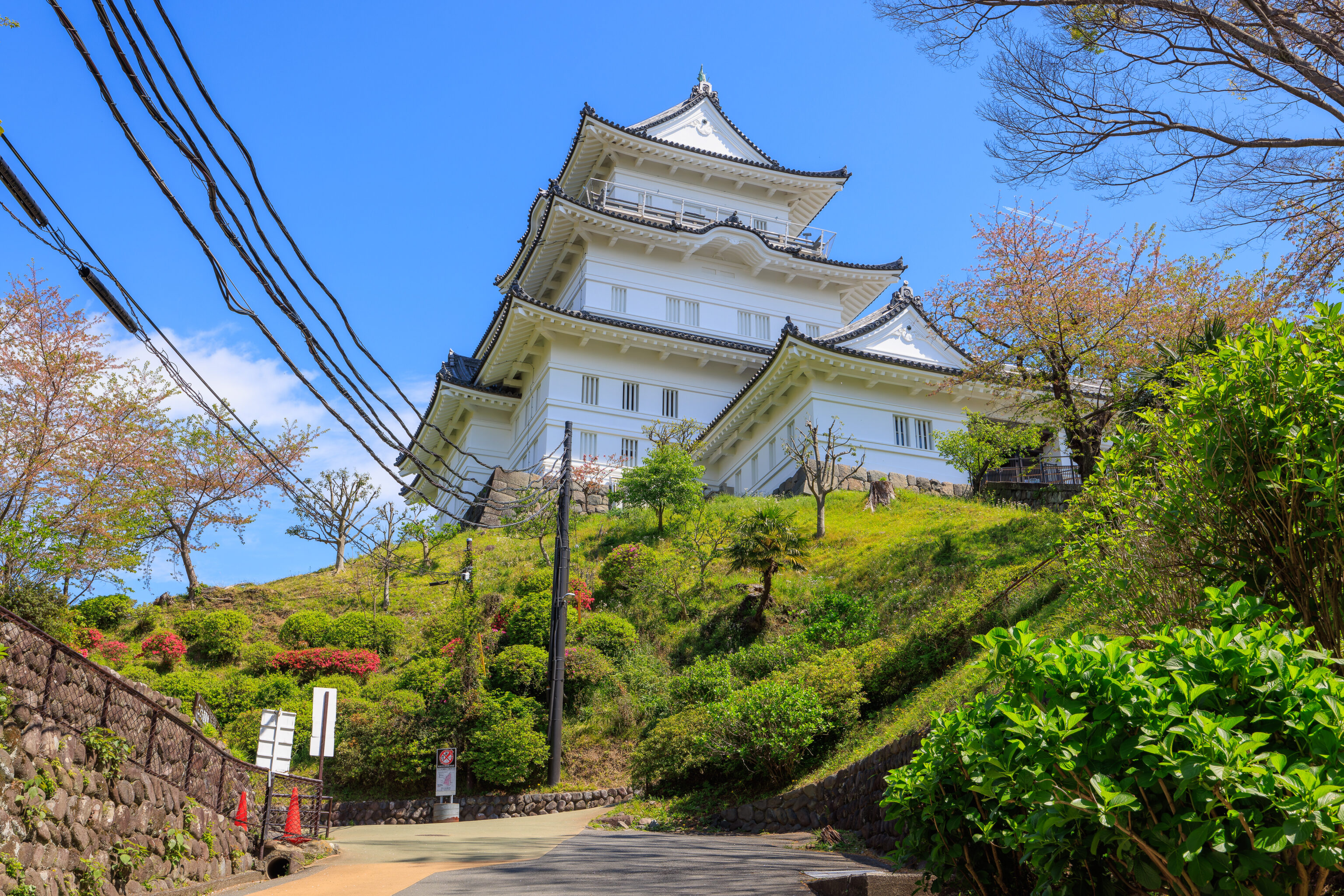
We did get a nice view of the castle keep behind us as we proceeded downhill.
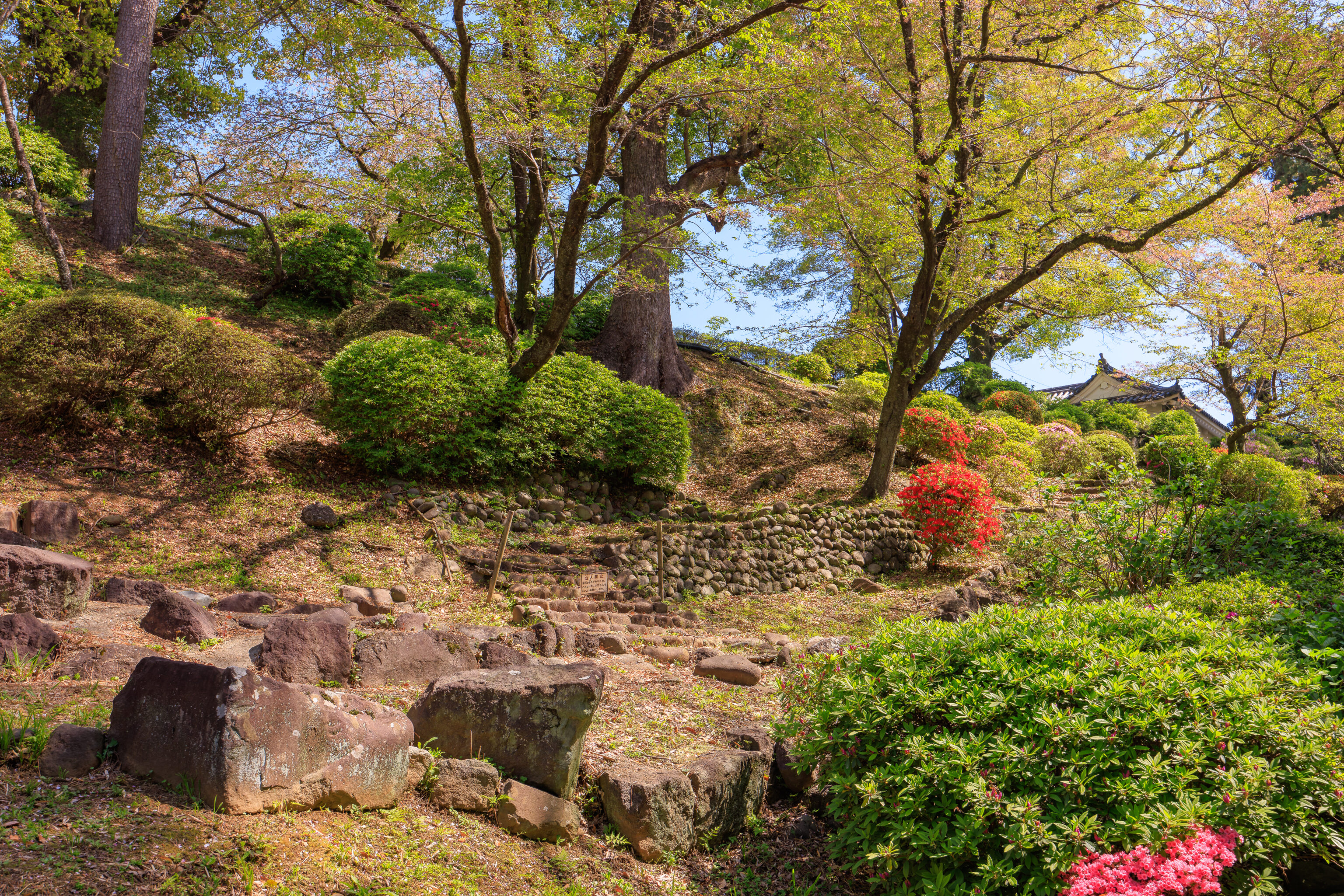
We continued walking as we passed by Honmaru Square on its south side.
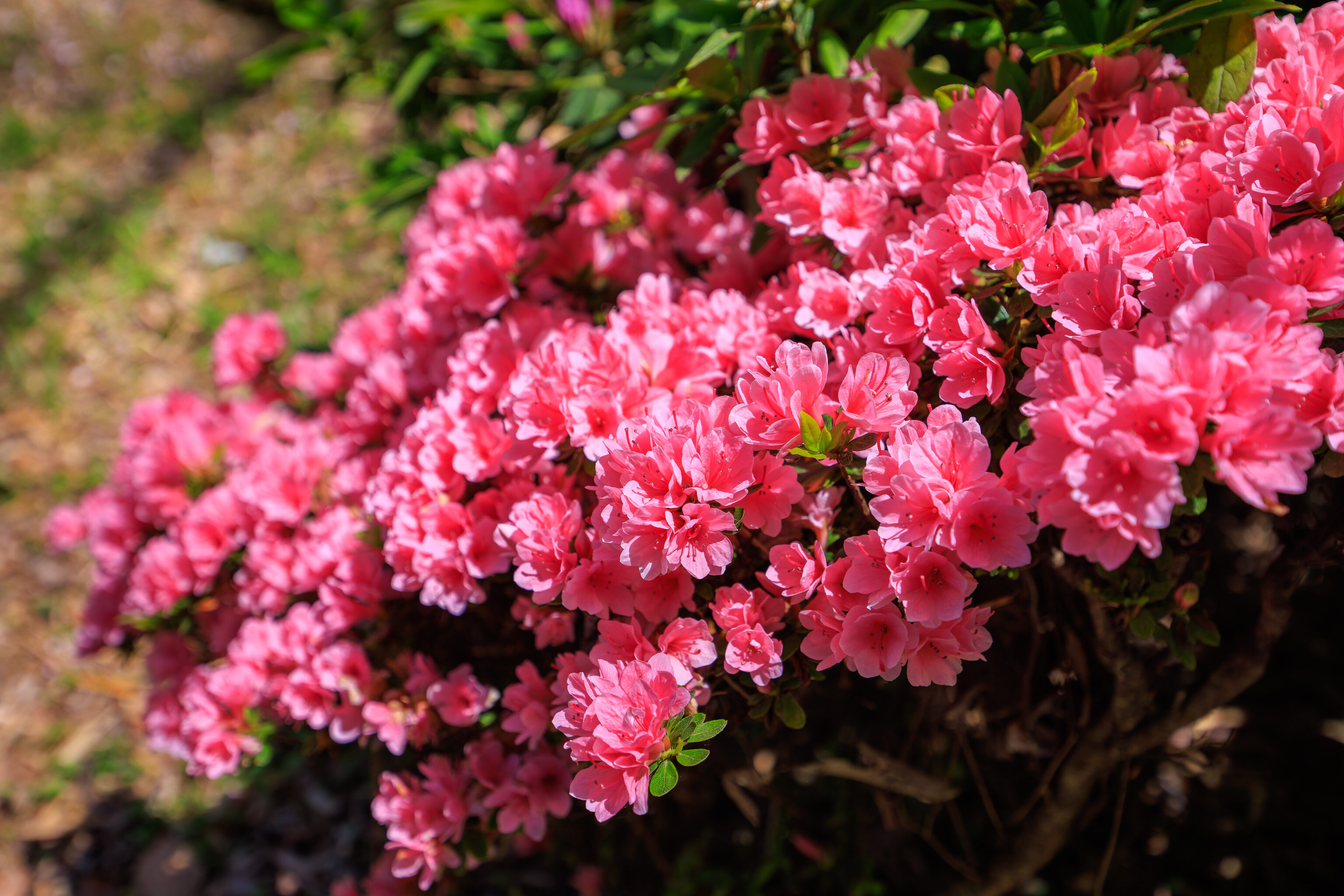
Although sakura season is well over here, we did see other flowers in bloom.
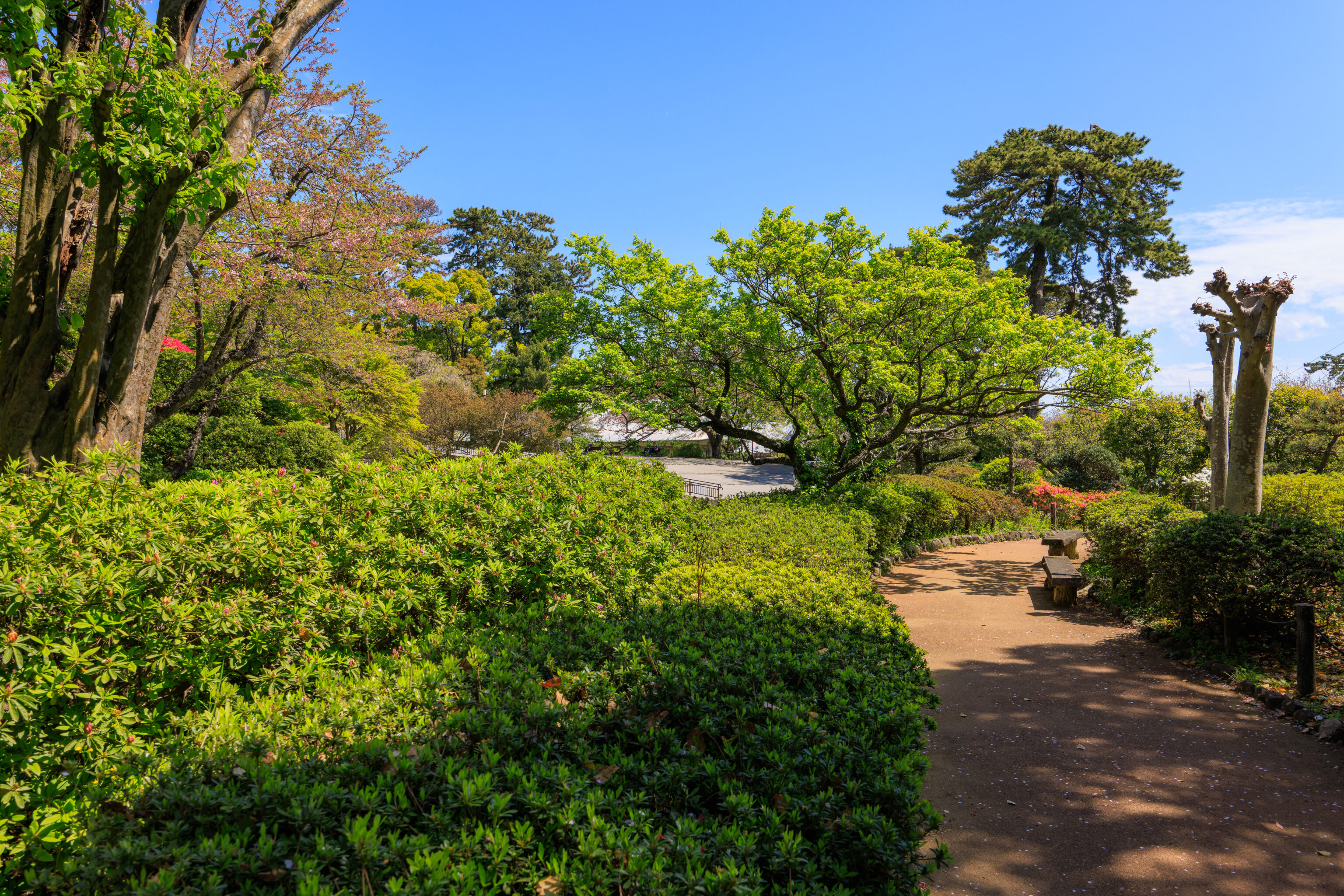
We continued walking to reach the east side of the castle grounds.
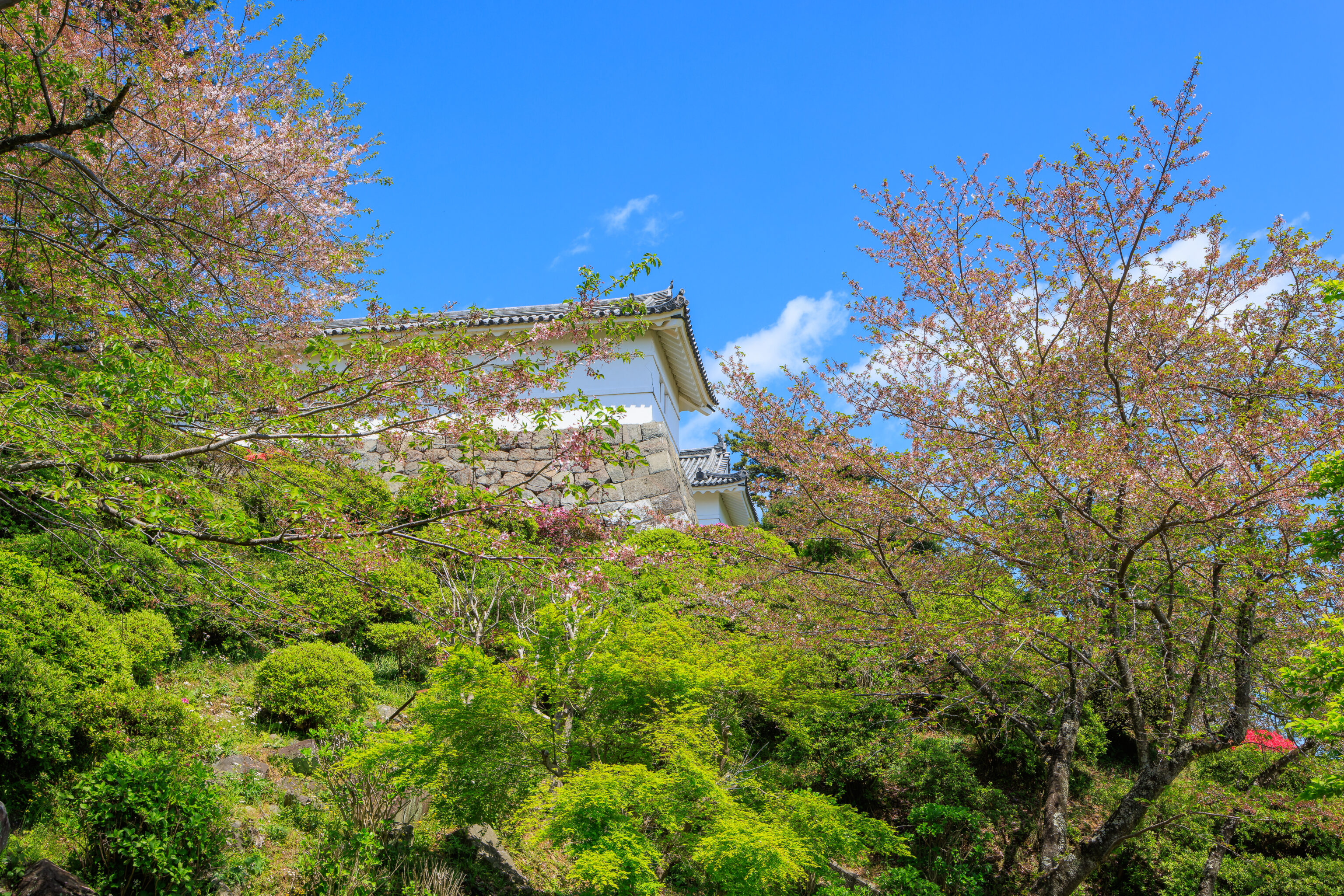
Looking up, we could see the keep’s gate structures above.
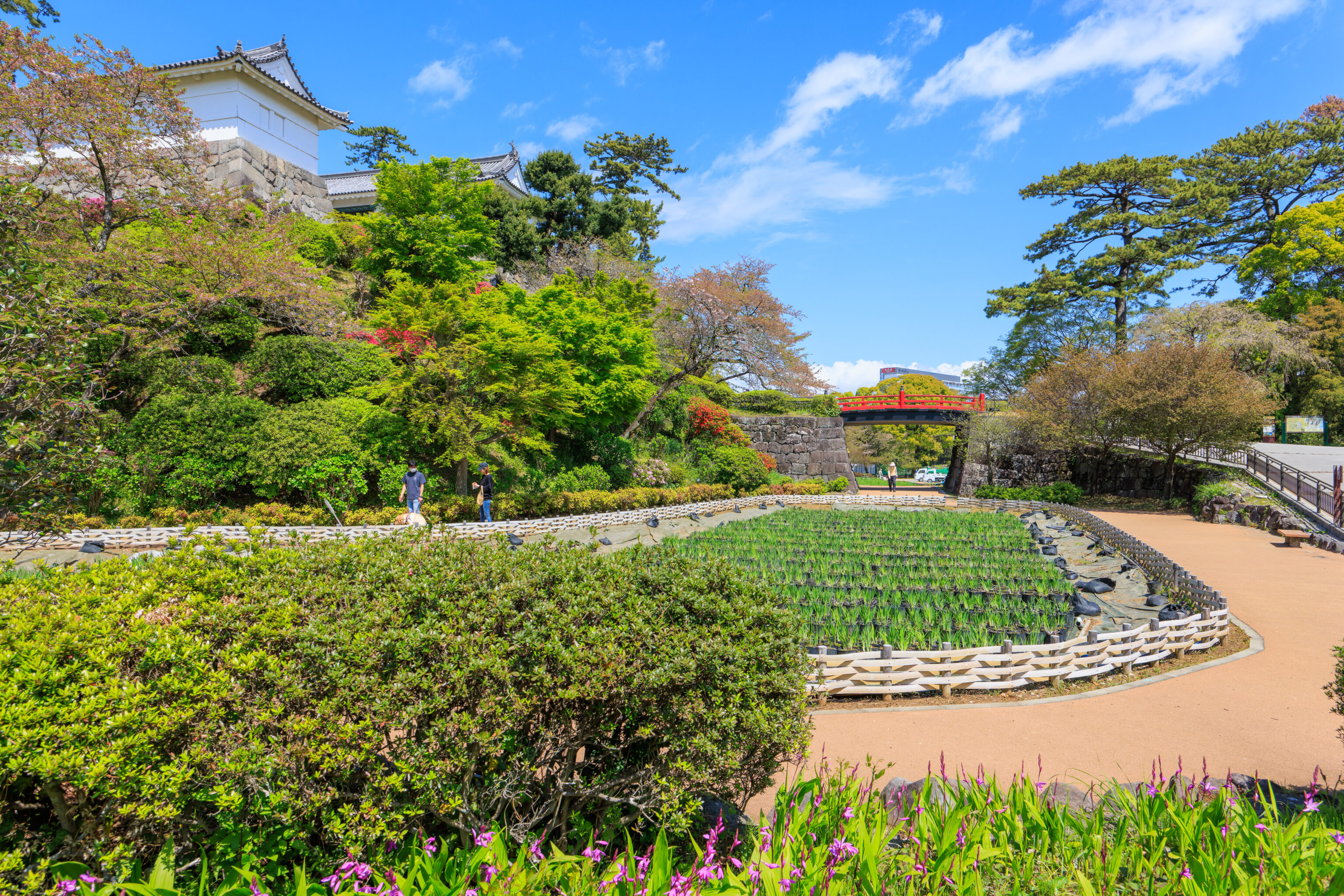
We saw more small fields in front of us as well as a red bridge that leads to the keep’s front gate.
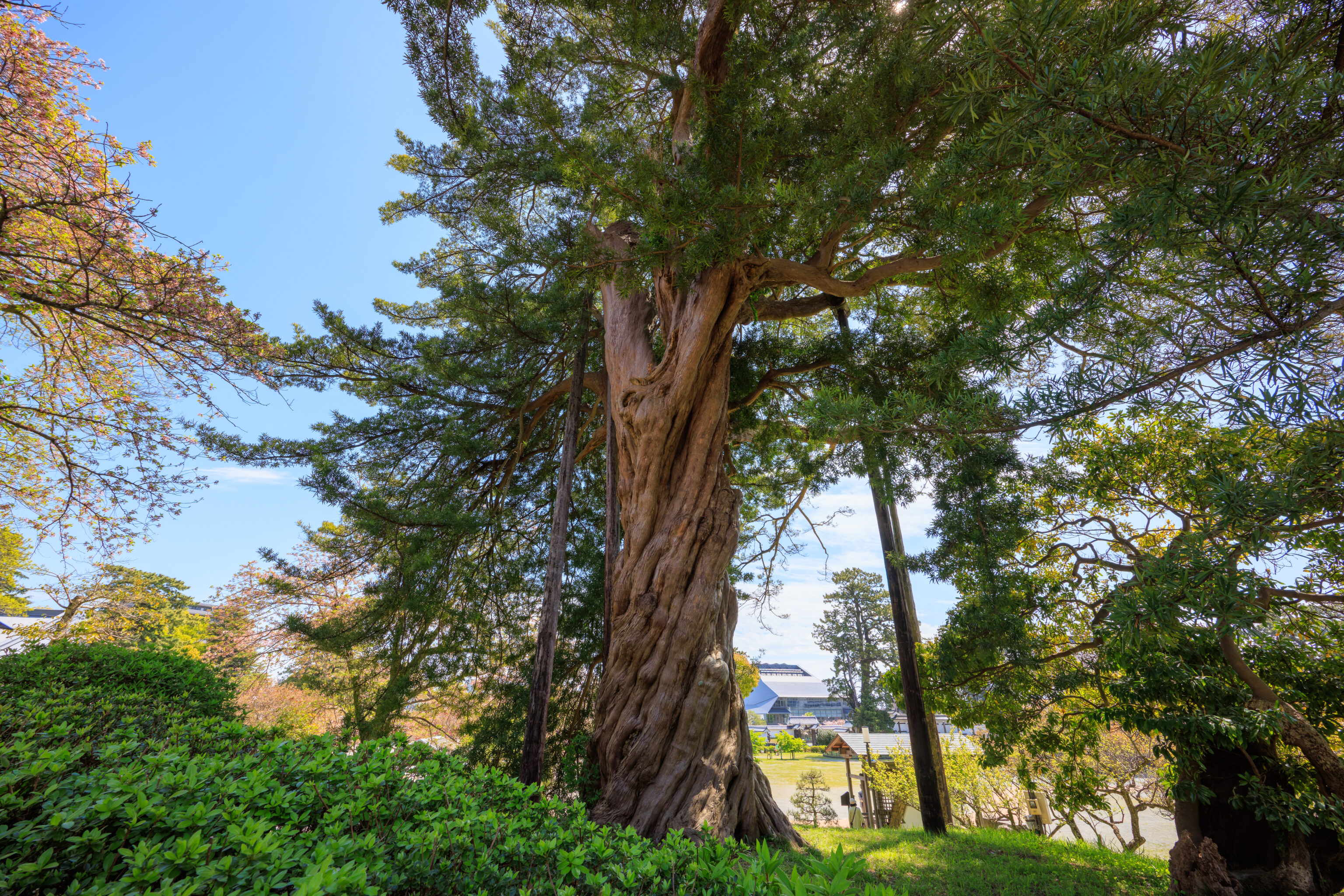
This particular tree, a 犬槇 Inumaki, is notable as it has a sign describing it. The sign reads, Google Translated to English:
Designated natural monument of Odawara City (designated March 30, 1974)
Inumaki at Odawara Castle Ruins
Location: 3-20m inside the castle
Tree circumference at eye level: 4.5m
Circumference at base of plant: Approximately 6m
Tree height: Approximately 20m
Branch spread: 25m east-west, 13m north-south
Inumaki is an evergreen tall tree representative of warm temperate forests that grows in forests along the coast from southern Kanto to the west, and is often seen in the precincts of shrines and temples in Odawara City.
This tree has a trunk circumference of 4.5m, making it the largest Inumaki in the city. The main trunk is twisted counterclockwise and branches into four branches five meters above the ground. Previously, it had dense branches spreading out in all directions, creating a magnificent umbrella-like appearance, but a large branch on the north side was broken by a typhoon, exposing part of the branch trunk, resulting in its current appearance.
However, its majestic and fierce appearance is spectacular, and among the many large and ancient trees within the Odawara Castle ruins, it is on a par with the giant pine tree in the main citadel.
Odawara City Board of Education
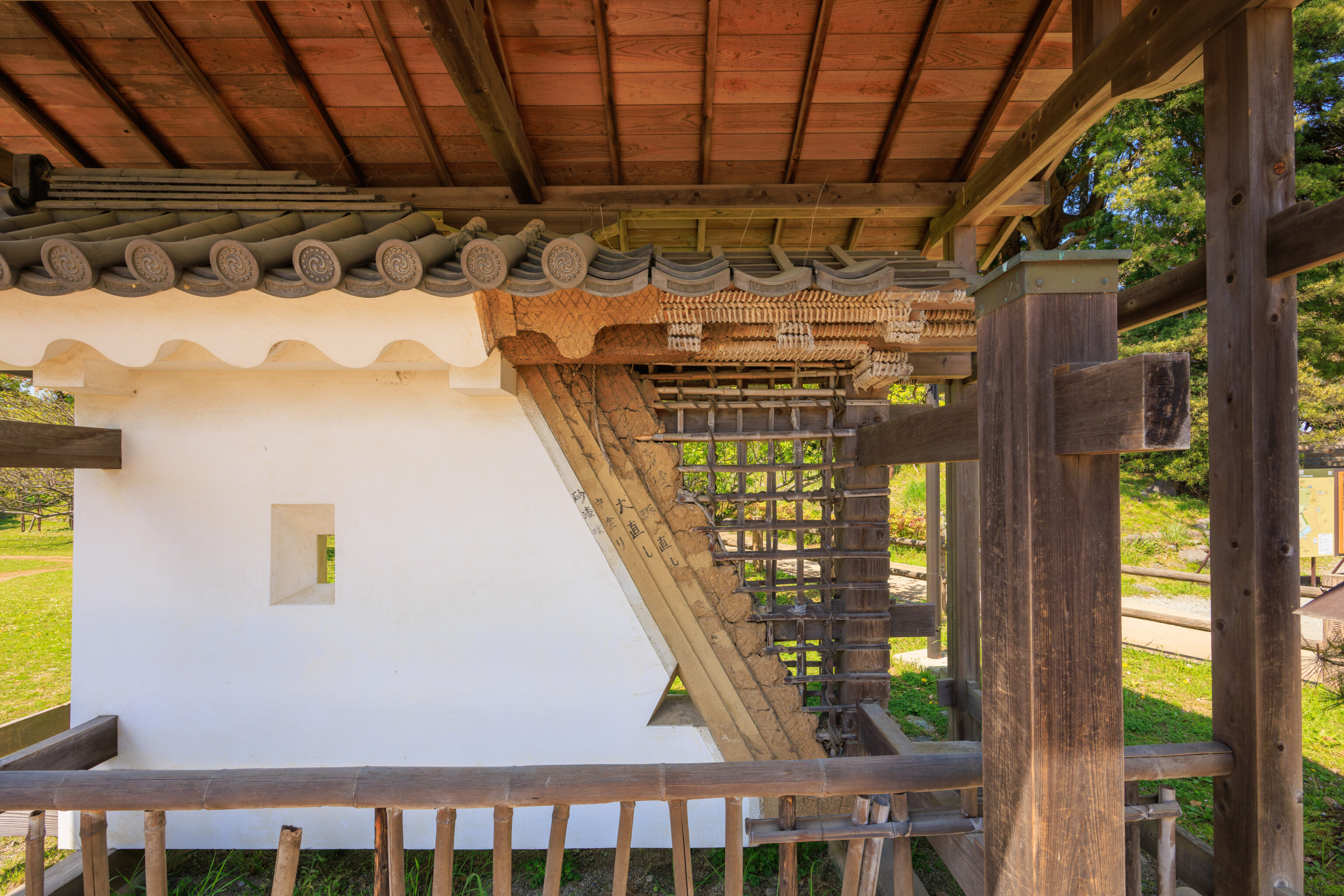
This example of a wall section shows how the gate walls are constructed. A sign provides just a few details:
This architectural model of mud wall was made before the construction of Akaganemon Gate.
Mud wall takes the important role to confirm the shrinkage and dry condition of the soil that can check the material of wood and white wall which had been used.
The text here is as-is on the sign. Google Translation of the Japanese text yields better results in this case:
This clay wall model was made prior to the construction of the Copper Gate, which was restored based on Edo period construction methods and techniques.
It played an important role in checking the shrinkage and drying of the wood and clay used in the white walls.
It was donated by the Odawara City Building Cooperative Association to help explain old architectural construction methods to everyone in an easy-to-understand way.
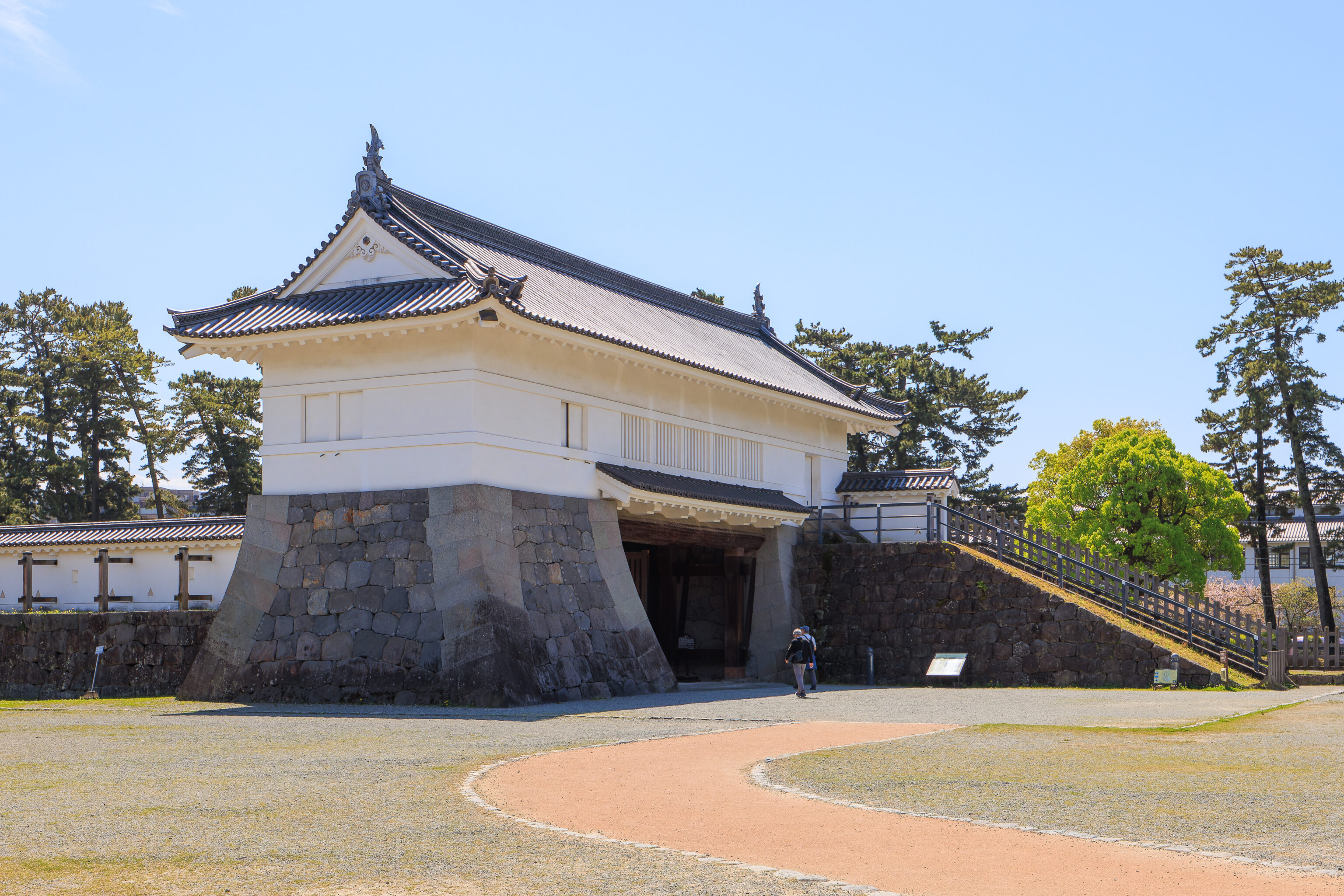
The gate the sign references is this one, the 銅門 Copper Gate (Akaganemon). Another sign describes this gate:
Akagane-mon Gate, located in front of Ninomaru (Second bailey), is a gate constructed in Masugata style which consists of a square courtyard enclosed by earthen walls and two gates, Watari-yagura-mon Gate (a gate with a roofed passage turret) and Uchi-shikiri-mon Gate. The doors of Akagane-mon Gate were decorated with akagane (copper), the origin of its name. Watari-yagura was equipped with a feature called Ishiotoshi, a place to fend off attacks by dropping stones. In 1997, the gate was restored using traditional construction methods.
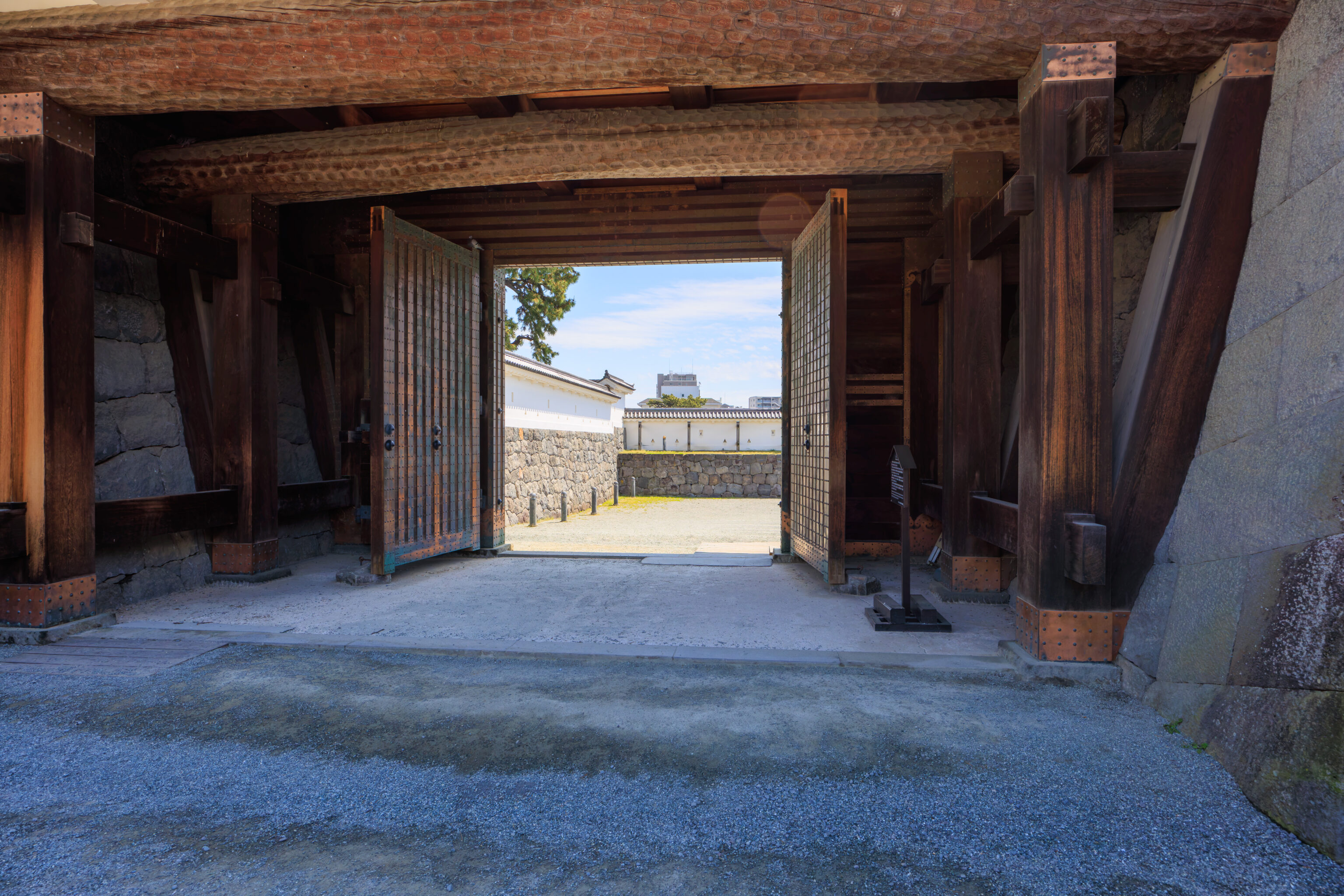
We walked through this gate to exit this area of the castle grounds. This was the view as we passed through.
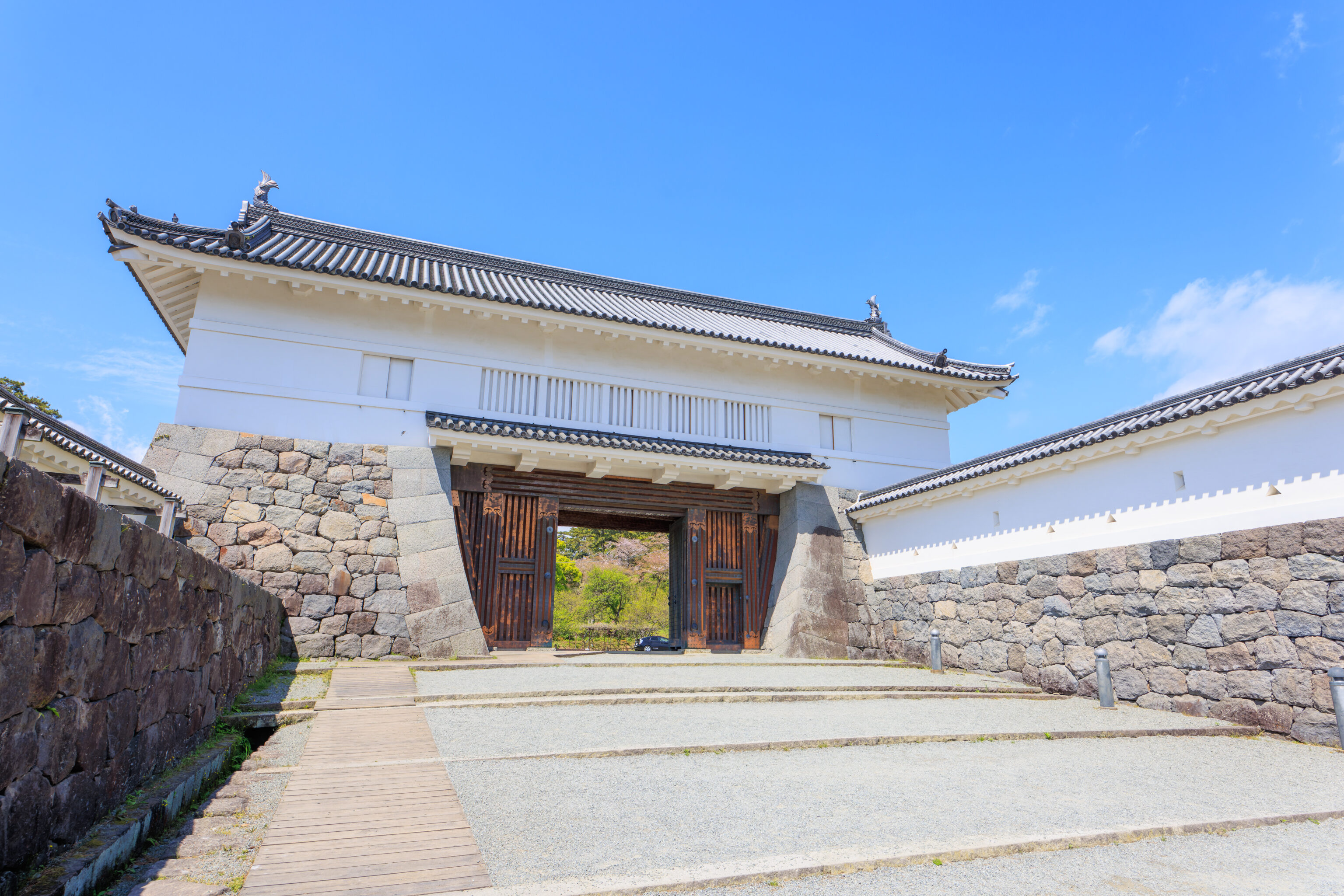
This is how the gate looks from the outside.
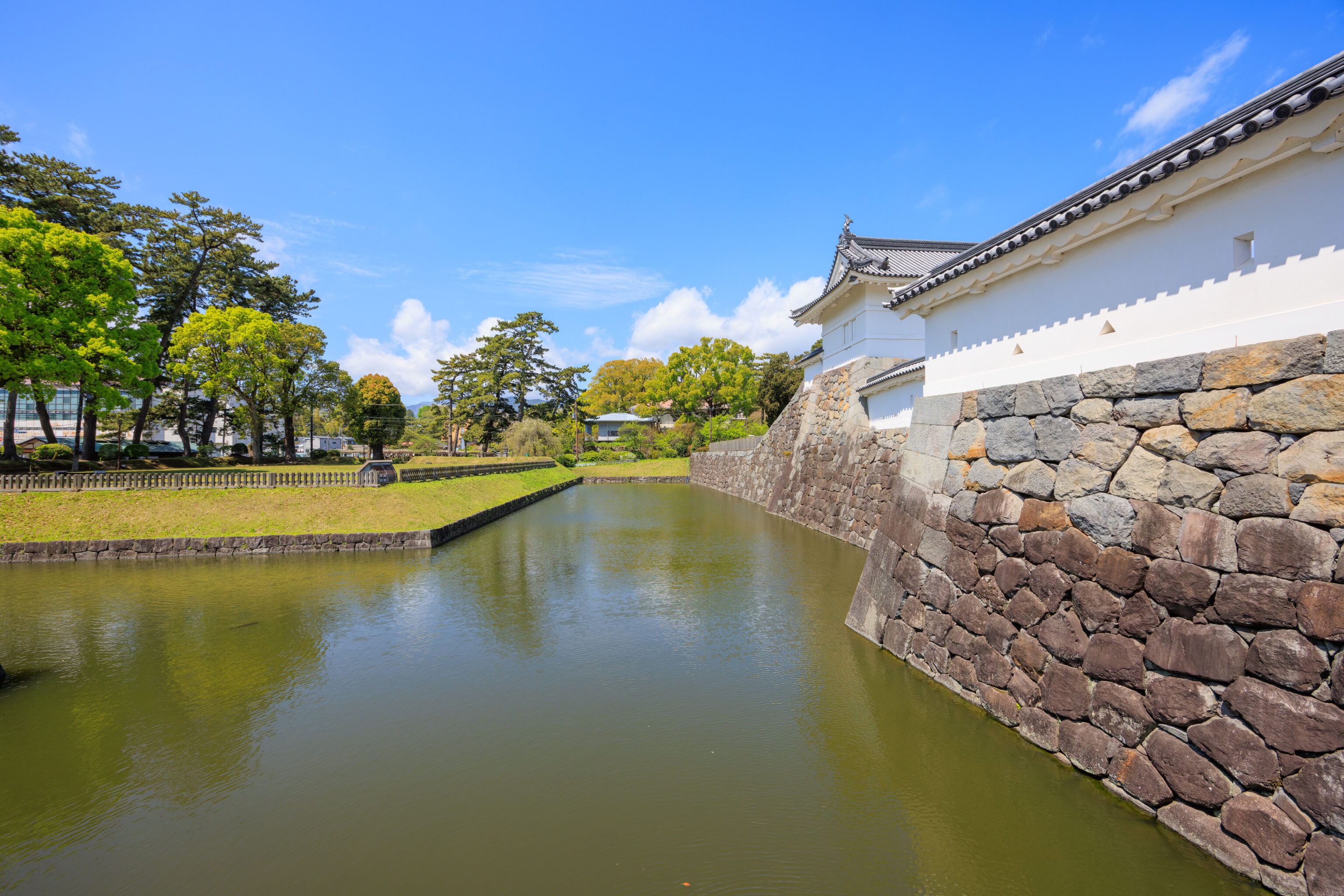
There is a second gate around the corner which leads to a small bridge that goes over the castle’s moat. A sign describes this moat:
Sumiyoshi moat separates Akagane-mon Gate at Ninomaru (second bailey) and Umaya-kuruwa Bailey. As the result of excavation and research, it was found that Sumiyoshi moat is comprised of a Shoji moat built in the Warring States period and different type of moat built in the Edo period (1603~1868). Shoji moats, which look as if Shoji screens were placed upright on the bottom, were the Hojo Clan preferred form of moats. In 1923, stone walls around the moat from the Edo period collapsed due to the Great Kanto Earthquake, but in 1993, they were reconstructed based on the excavated evidence and castle blueprints.
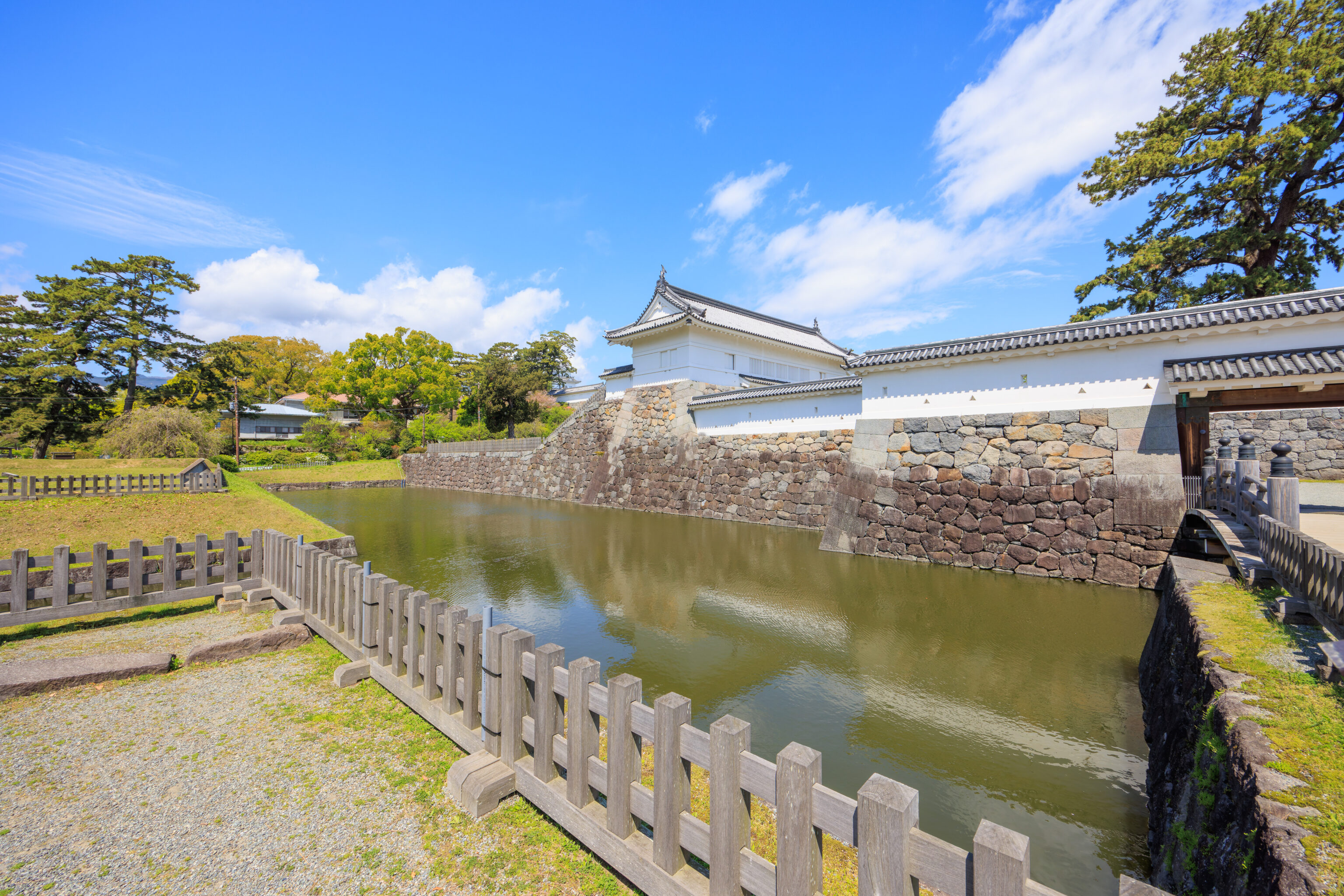
The gate as seen from the other side of the bridge across the moat.
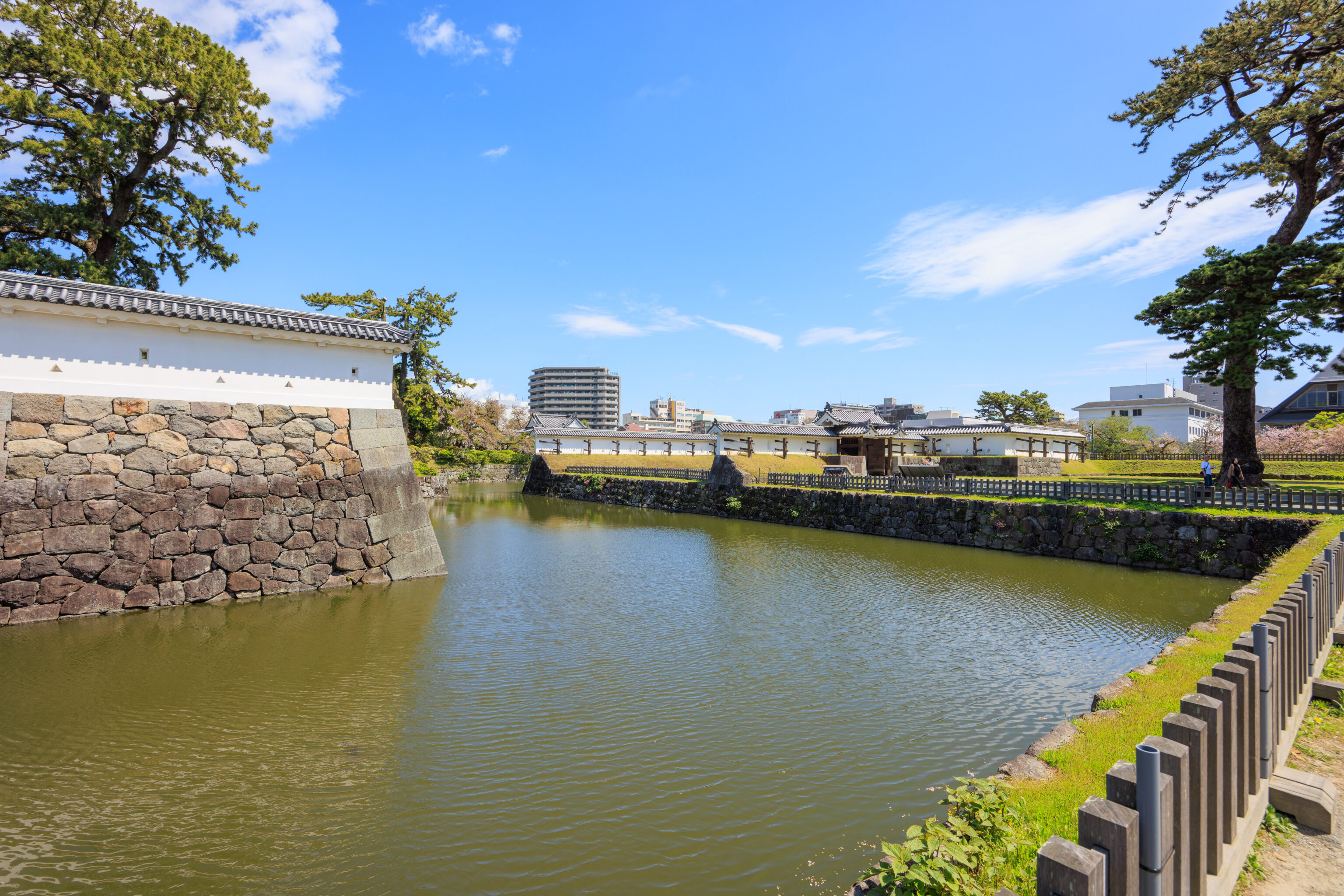
There was another gate ahead that we had to pass through to exit. A sign nearby once again describes the Copper Gate:
Odawara Jo Akagane Mon (Odawara Castle Akagane Gate)
This gate, the main entrance of Odawara Castle's second bailey, was built in the early Edo Period (1603-1867). It was demolished at the beginning of the Meiji Period (1868-1912). The present gate was rebuilt in 1997 in the style of the original structure based on excavation findings and old drawings.
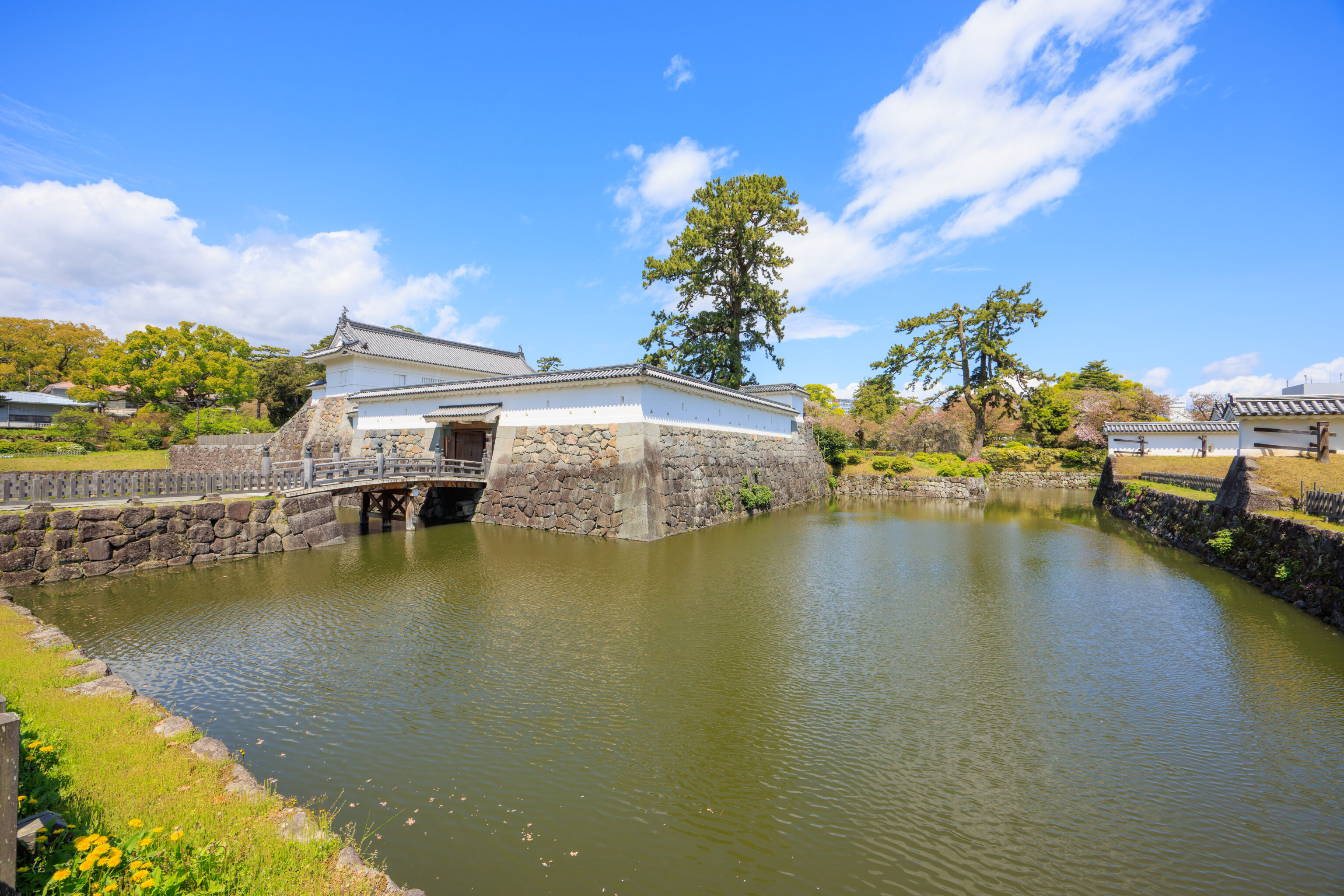
The gate as seen from the southeast corner of this section of the moat.
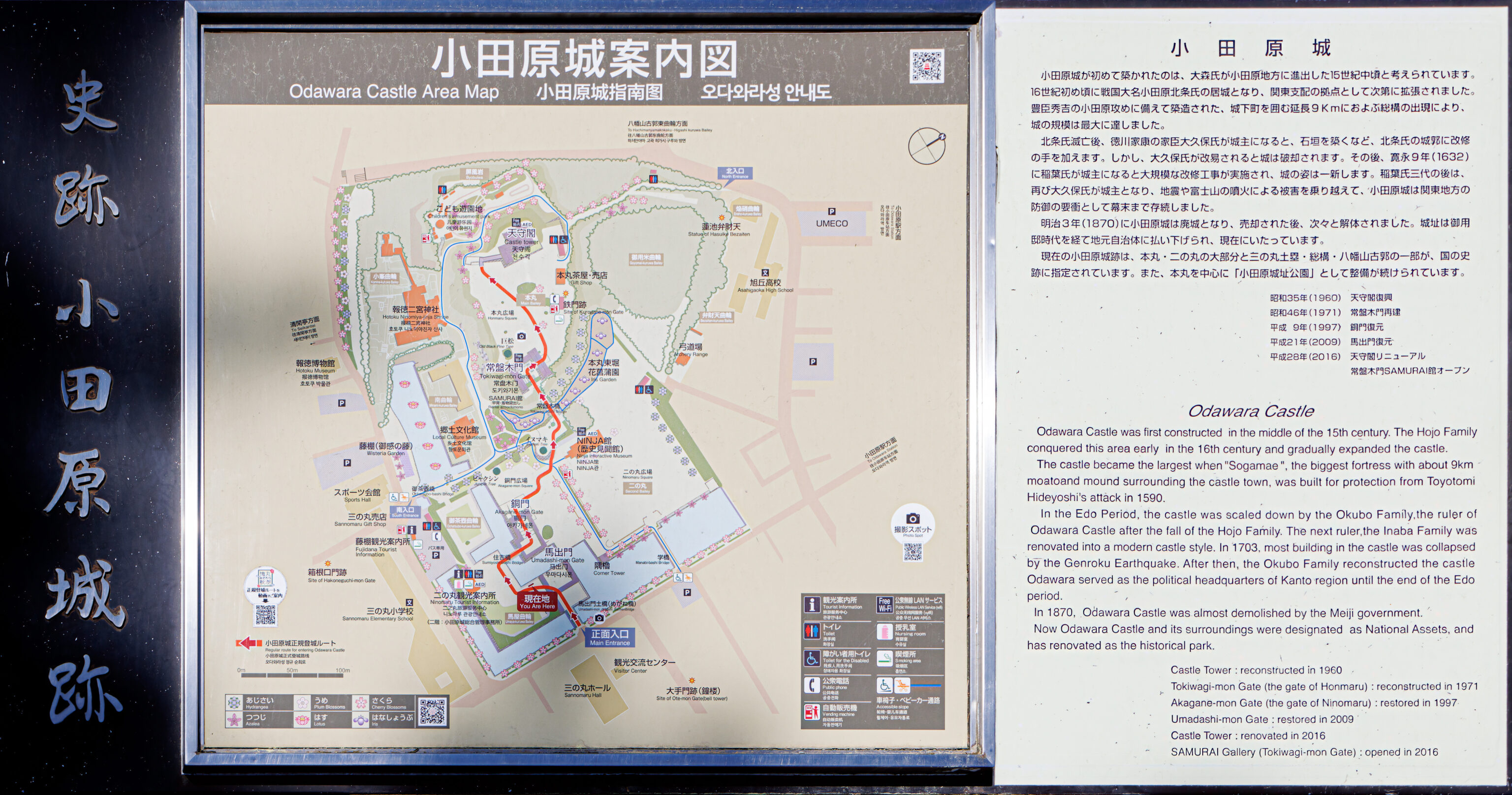
We found a sign nearby that provided a map and an overview of the castle. The main entrance is just ahead of us. The English text on the sign reads:
Odawara Castle
Odawara Castle was first constructed in the middle of the 15th century. The Hojo Family conquered this area early in the 16th century and gradually expanded the castle.
The castle became the largest when "Sogamae", the biggest fortress with about 9km moat and mound surrounding the castle town, was built for protection from Toyotomi Hideyoshi's attack in 1590.
In the Edo Period, the castle was scaled down by the Okubo Family, the ruler of Odawara Castle after the fall of the Hojo Family. The next ruler, the Inaba Family was renovated into a modern castle style. In 1703, most building in the castle was collapsed by the Genroku Earthquake. After then, the Okubo Family reconstructed the castle Odawara served as the political headquarters of Kanto region until the end of the Edo period.
In 1870, Odawara Castle was almost demolished by the Meiji government. Now Odawara Castle and its surroundings were designated as National Assets, and has renovated as the historical park.
Castle Tower: reconstructed in 1960
Tokiwagi-mon Gate (the gate of Honmaru): reconstructed in 1971
Akagane-mon Gate (the gate of Ninomaru): restored in 1997
Umadashi-mon Gate: restored in 2009
Castle Tower: renovated in 2016
SAMURAI Gallery (Tokiwagi-mon Gate): opened in 2016
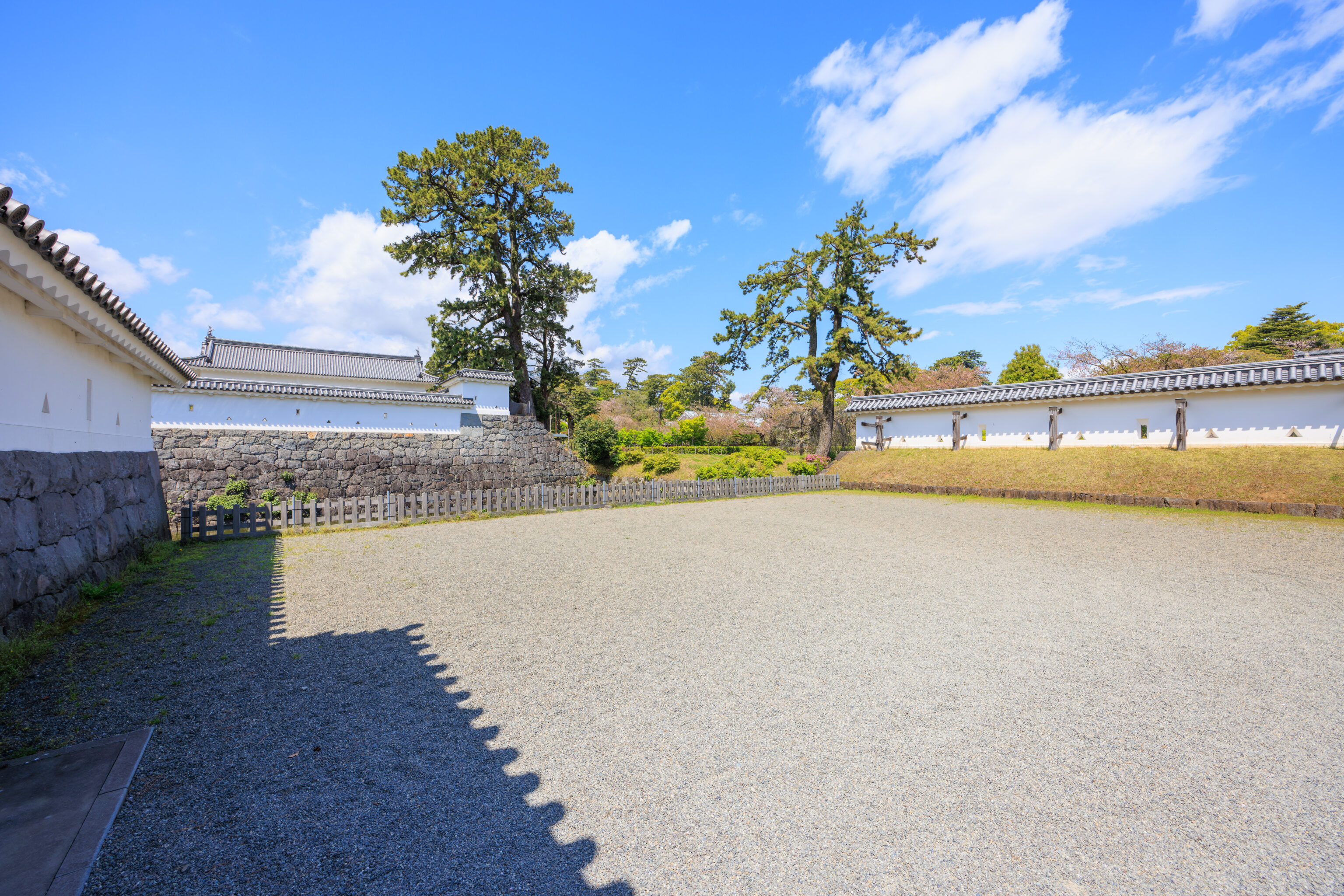
We passed through the final area before exiting the castle grounds.
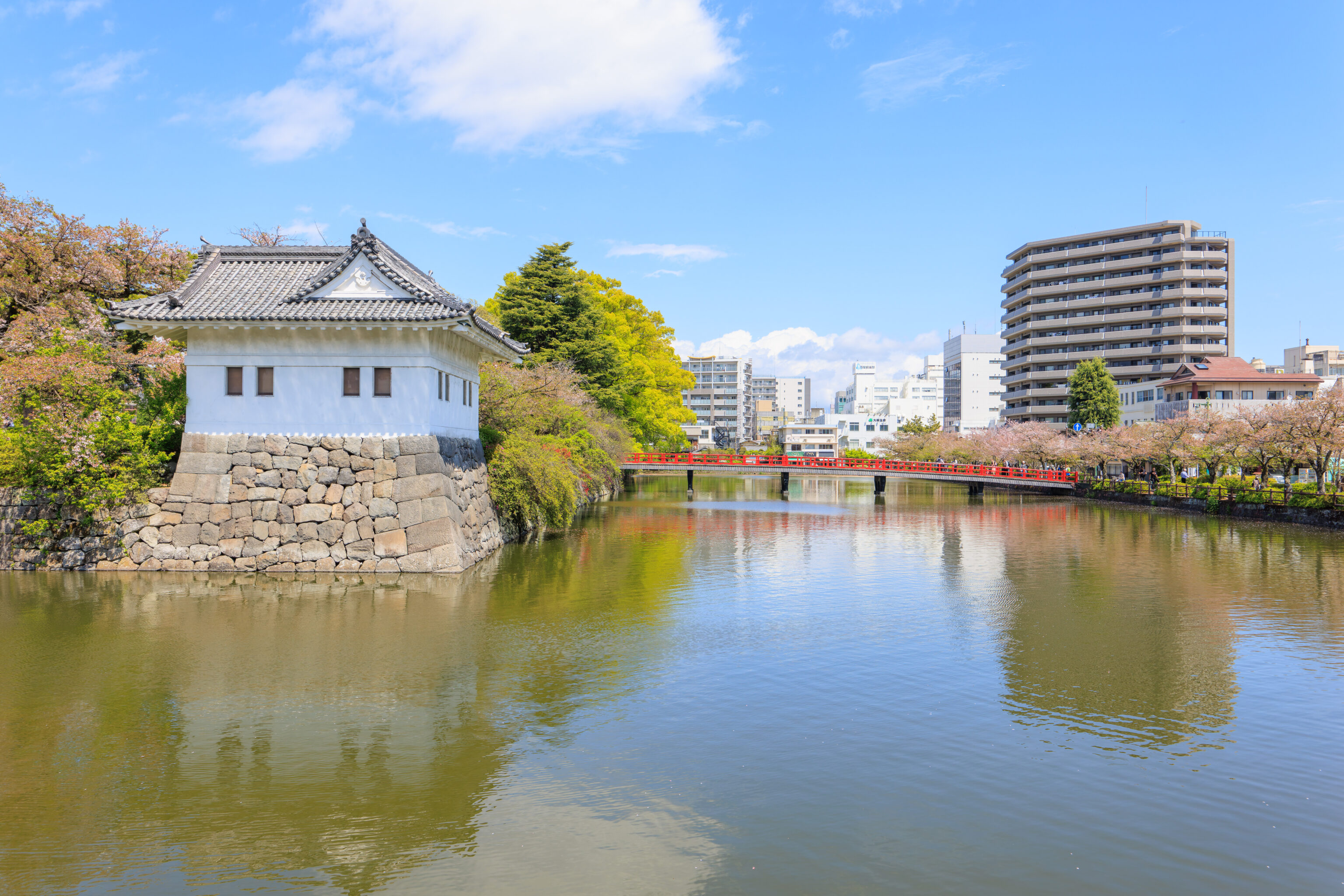
We were now outside the castle with one last bridge to cross to exit the outer area of the moat. Looking to the north, in the direction of Odawara Station, we could see a long red bridge, identified as 学橋 Manabi-bashi on the map, which provides an alternate route into the castle.
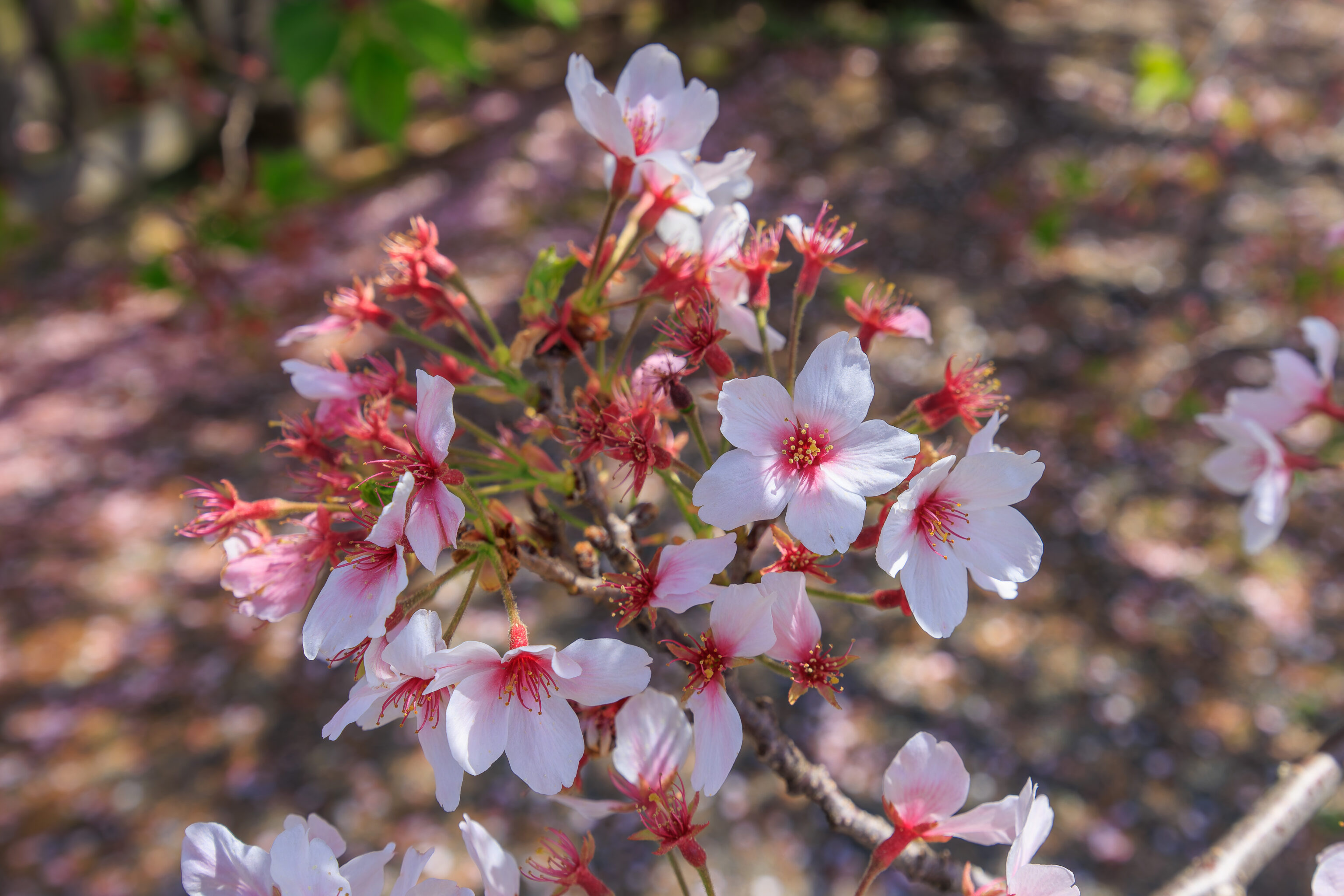
Odawara Castle seems to have quite a bit of sakura on and around the castle grounds! It seems like this would be a nice and easy place to visit during sakura season, particularly due to its proximity to the train station.
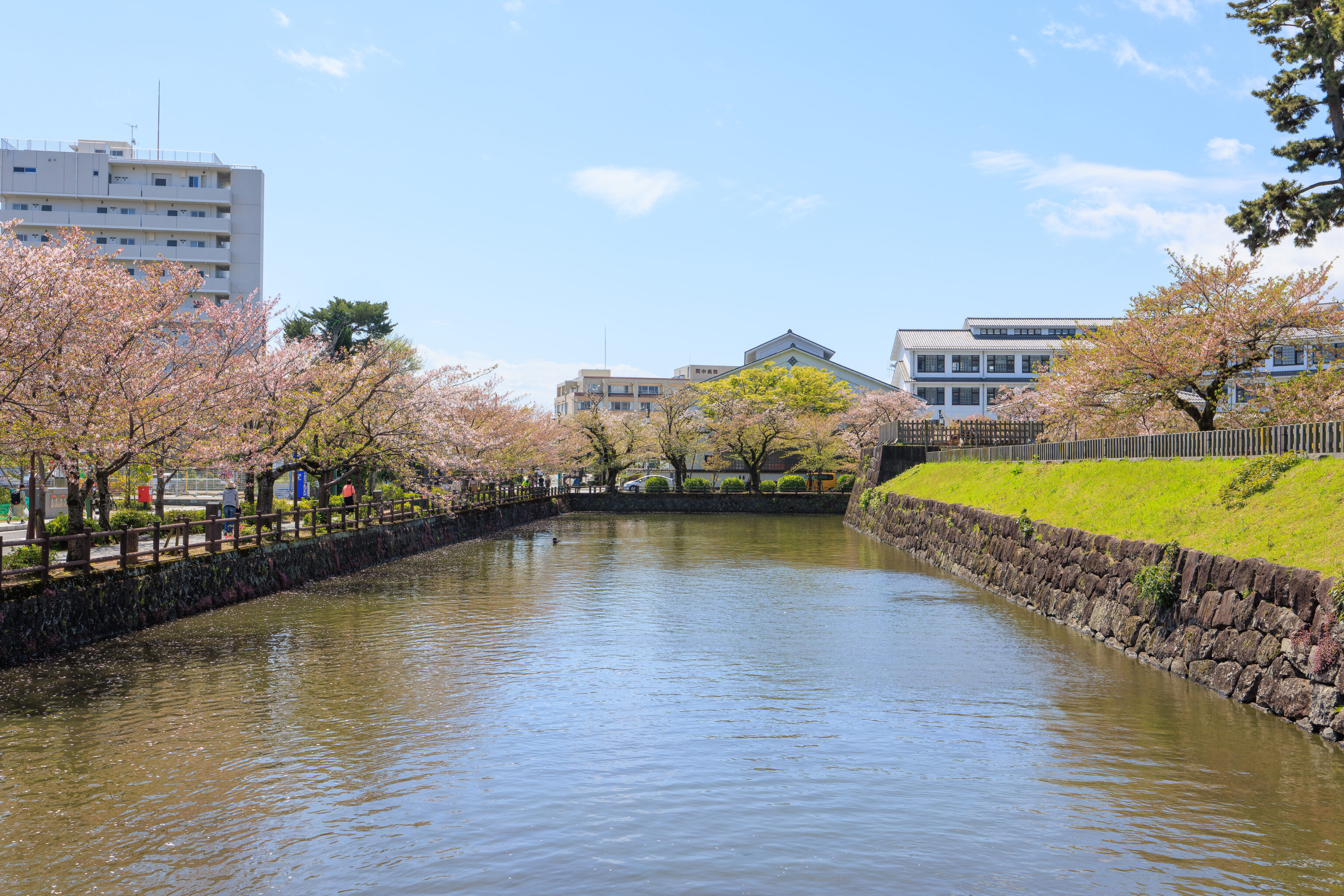
Looking to the south, we could see the southern end of the moat as well as more sakura.
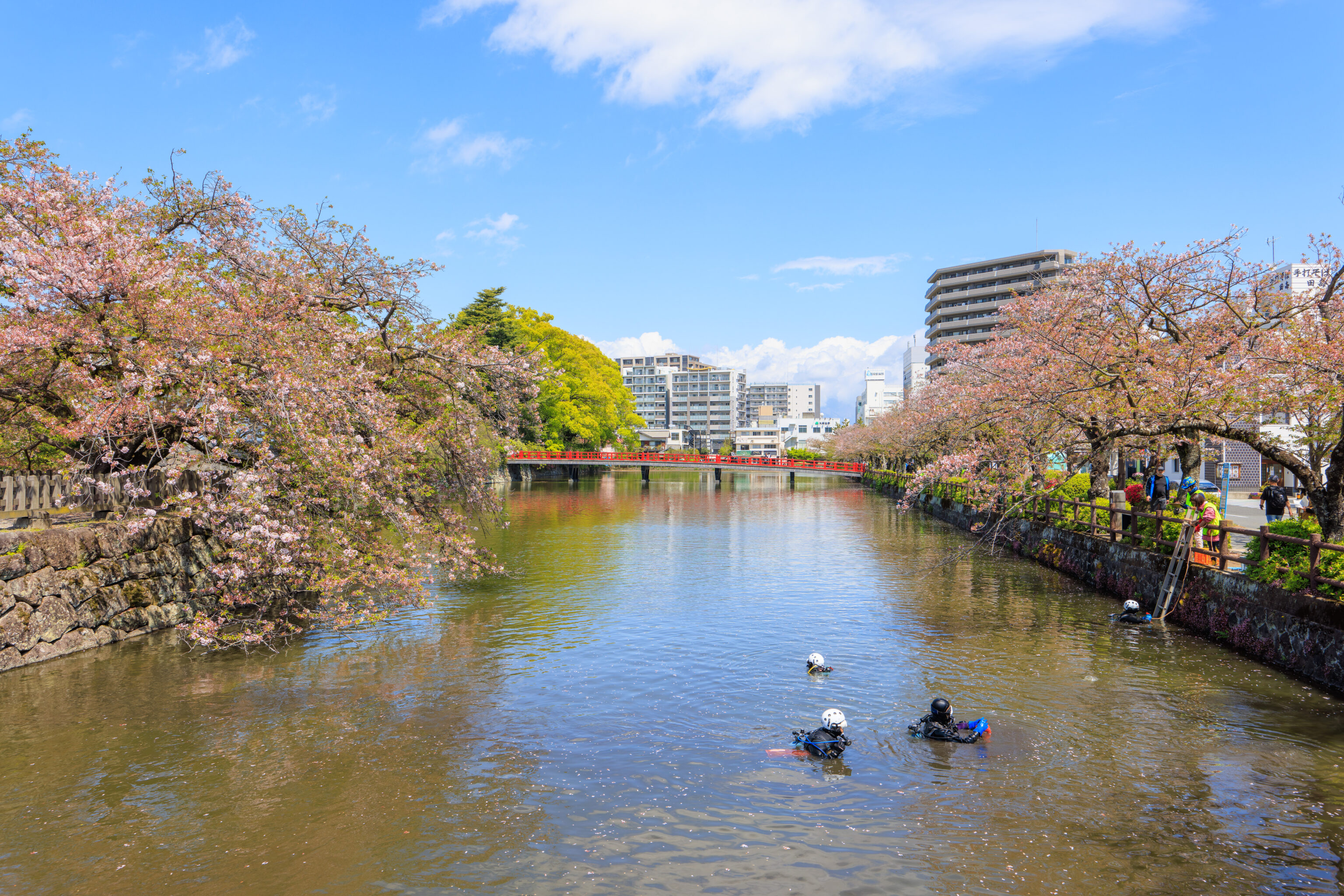
We noticed something in the moat. Divers! They were picking up garbage from the moat!
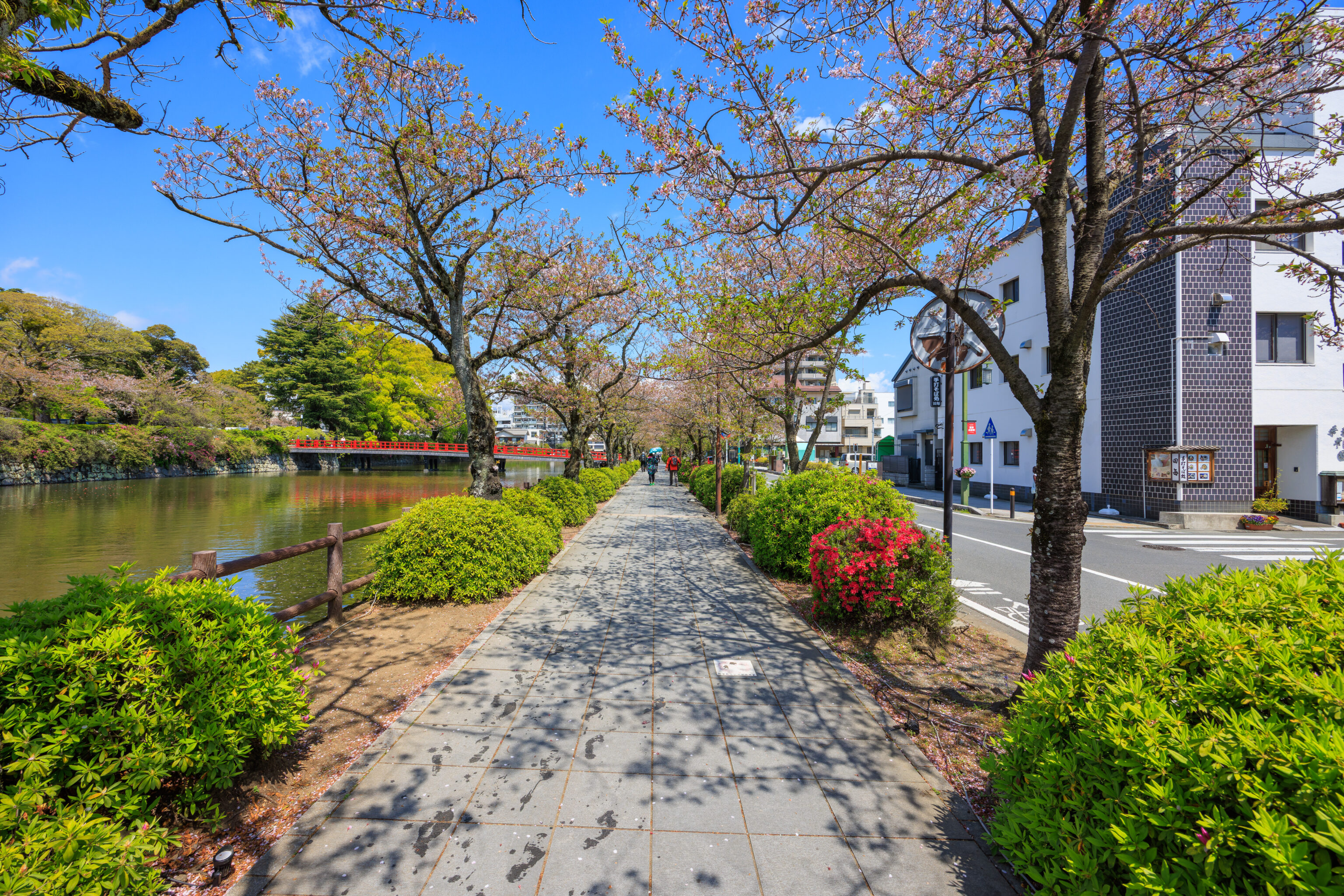
We started walking to the north along a sakura lined path between the moat and the adjacent road.
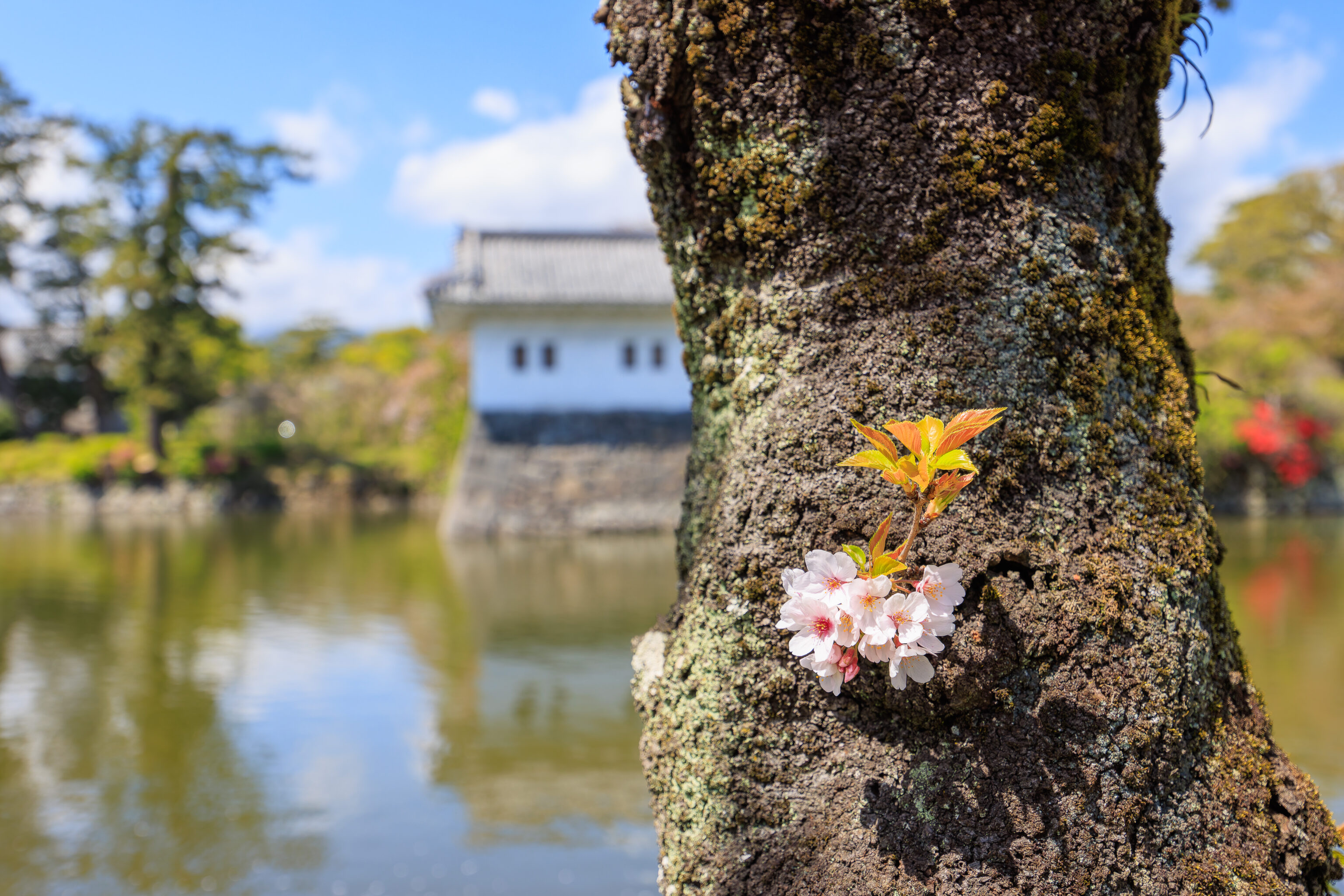
This little clump of sakura was quite pretty with the moat and Corner Tower in the background.
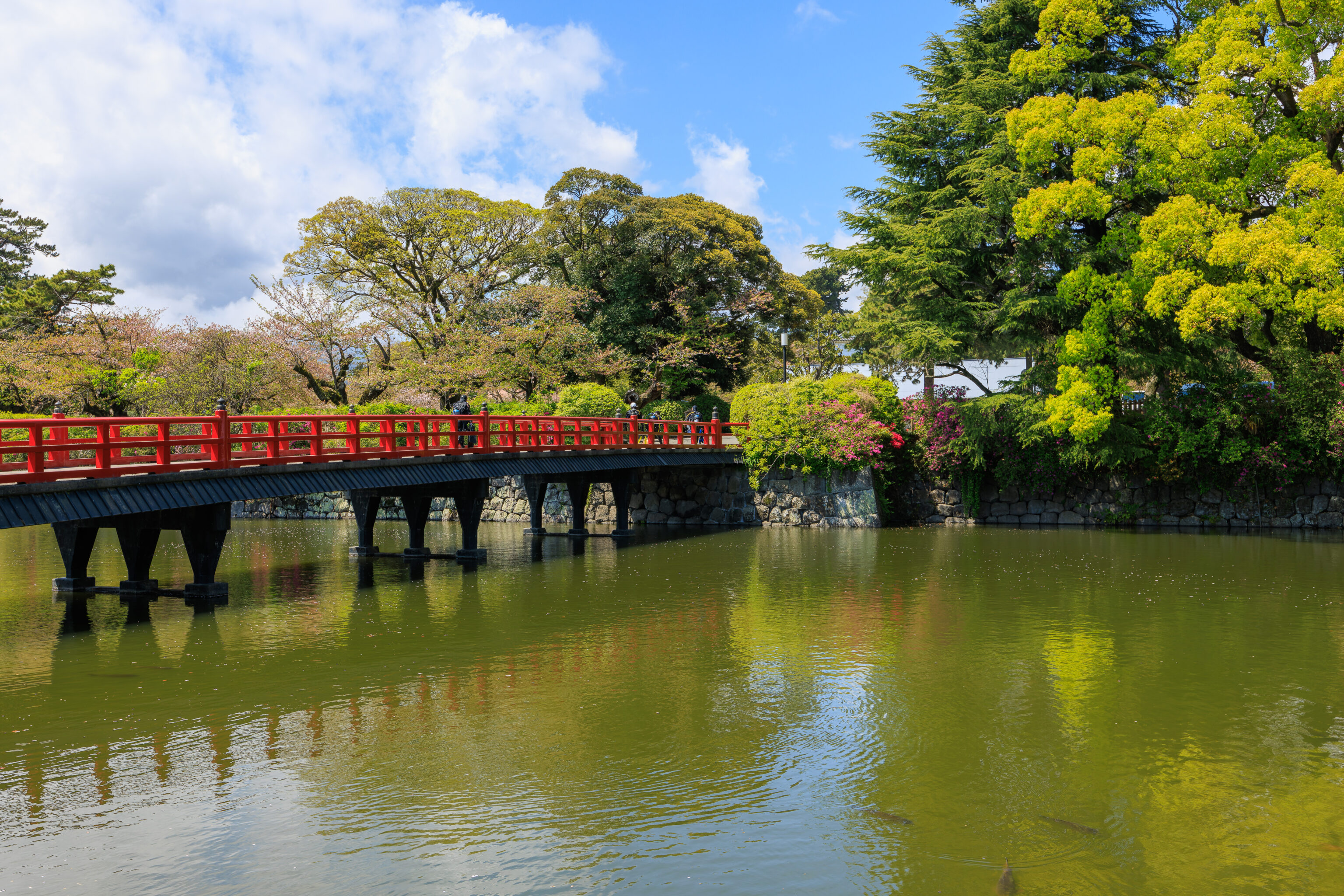
We continued to the north, passing the Manabi-bashi.
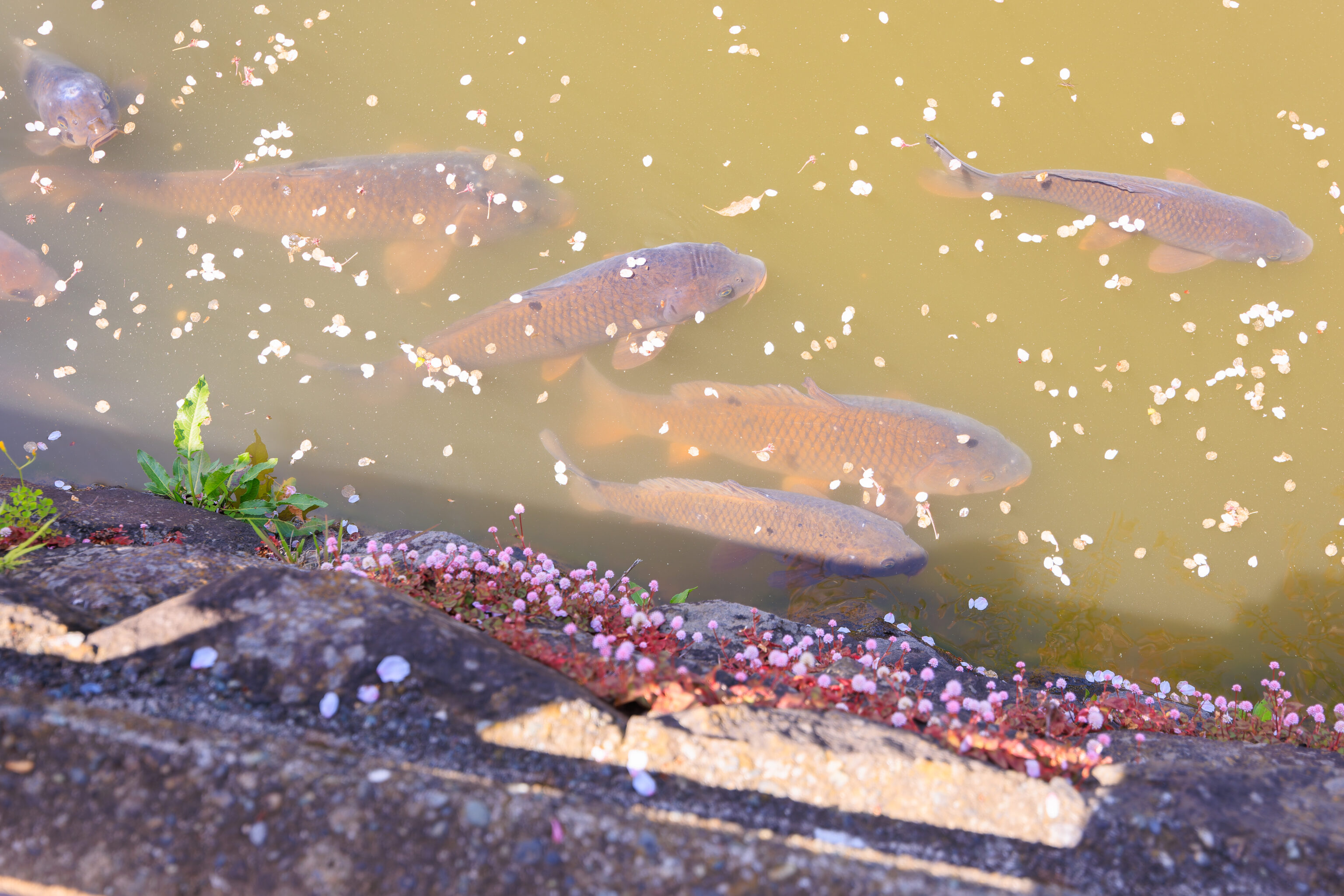
We saw many koi in the moat.
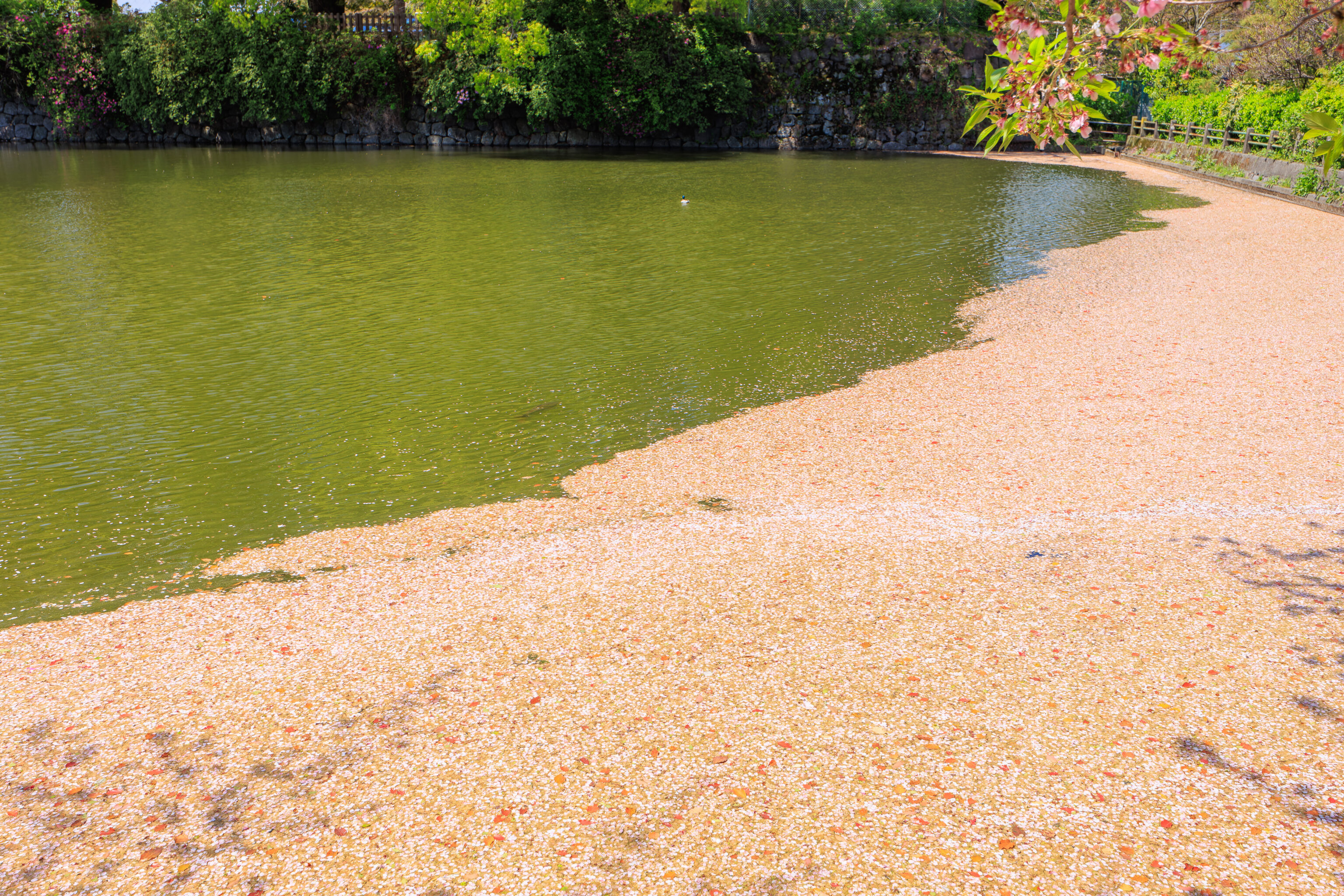
We soon reached the northeast corner of the moat where a massive amount of sakura petals were covering the moat’s surface!
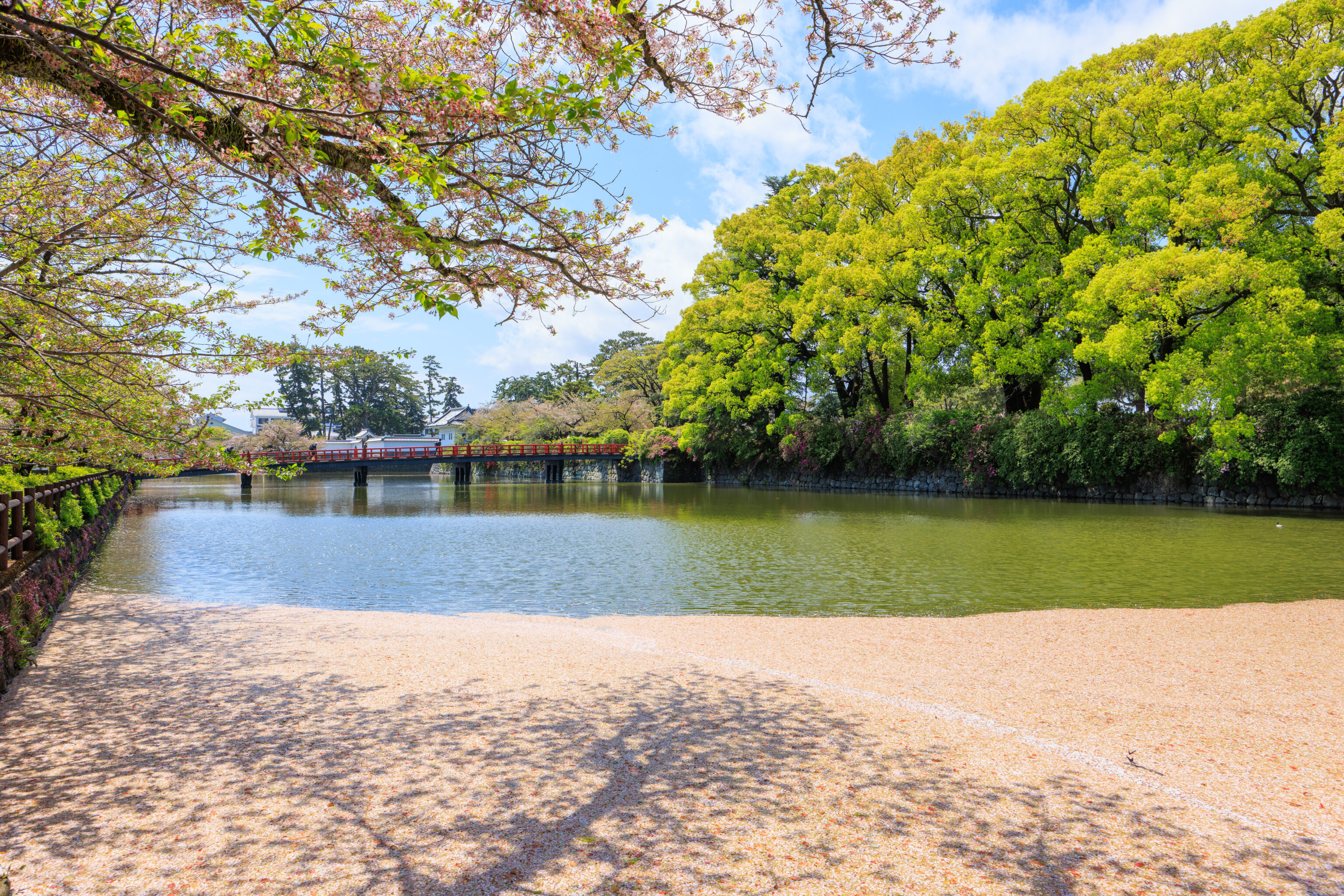
It almost appears as if you could walk on it!
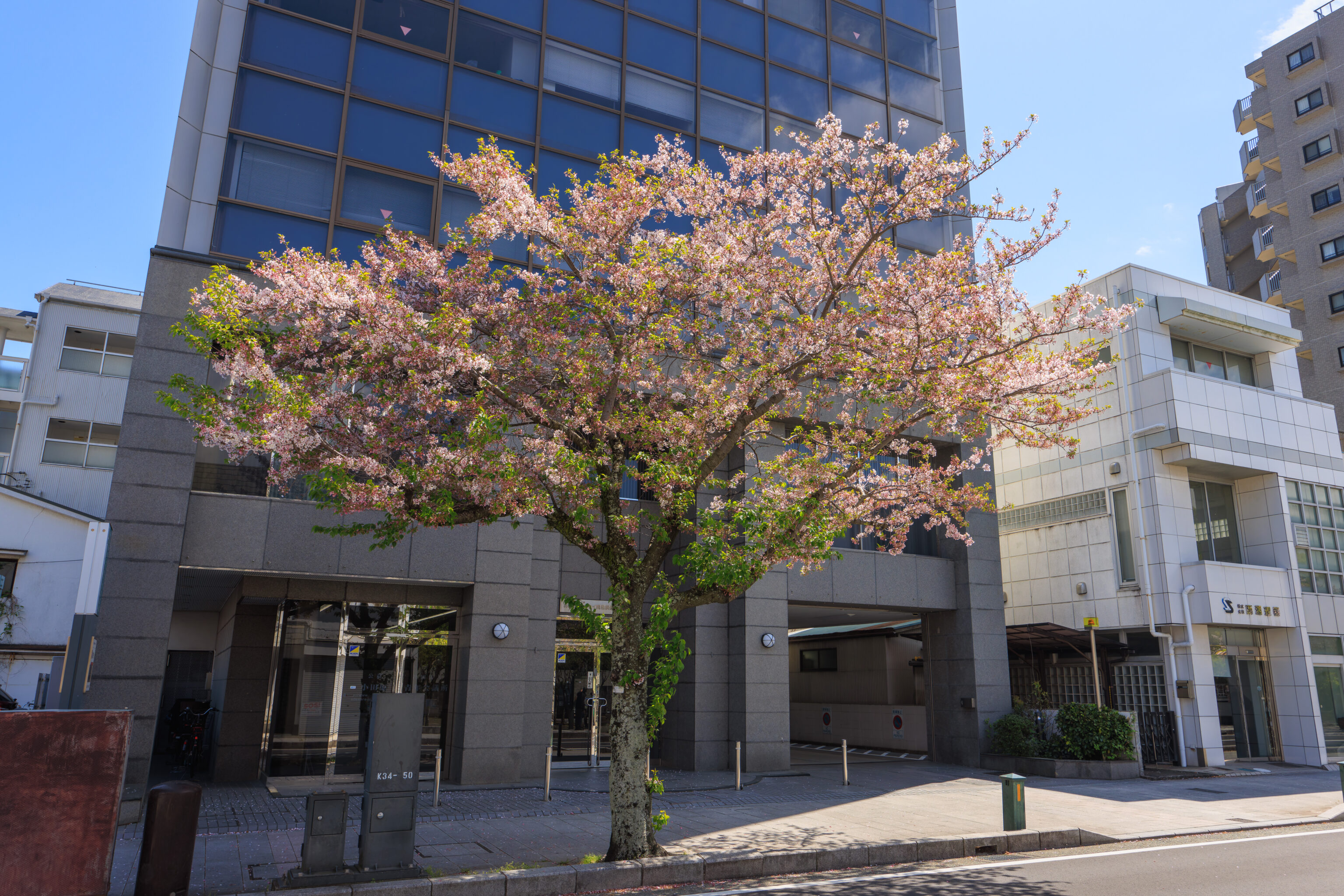
We continued on beyond the castle to return to Odawara Station. We passed by this leafy sakura that still had a surprising amount of flower petals still attached.
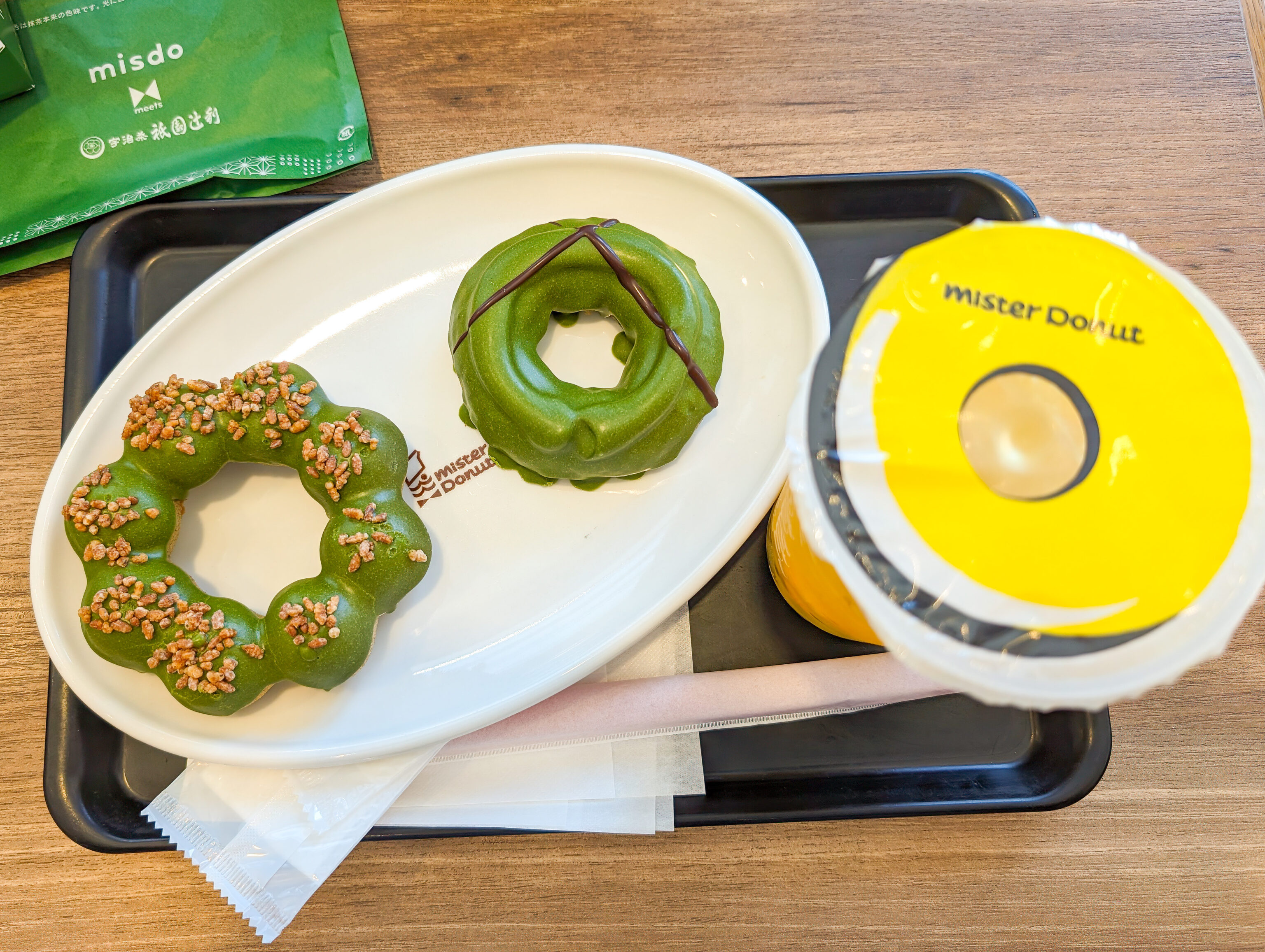
We decided to have a snack at the Mister Donut in front of the station. This chain apparently originates from the Untied States, though only one remains as the US stores were purchased by Dunkin’ Donuts1. Mister Donut is quite prevalent in Japan, though not particularly highly rated. We visited because they had some special items with matcha from Tsujiri, one of our favorite brands from Kyoto. They were just ok. We also got a pineapple and passion fruit drink, which was also just ok. It had some jelly ingredient from Taiwan.
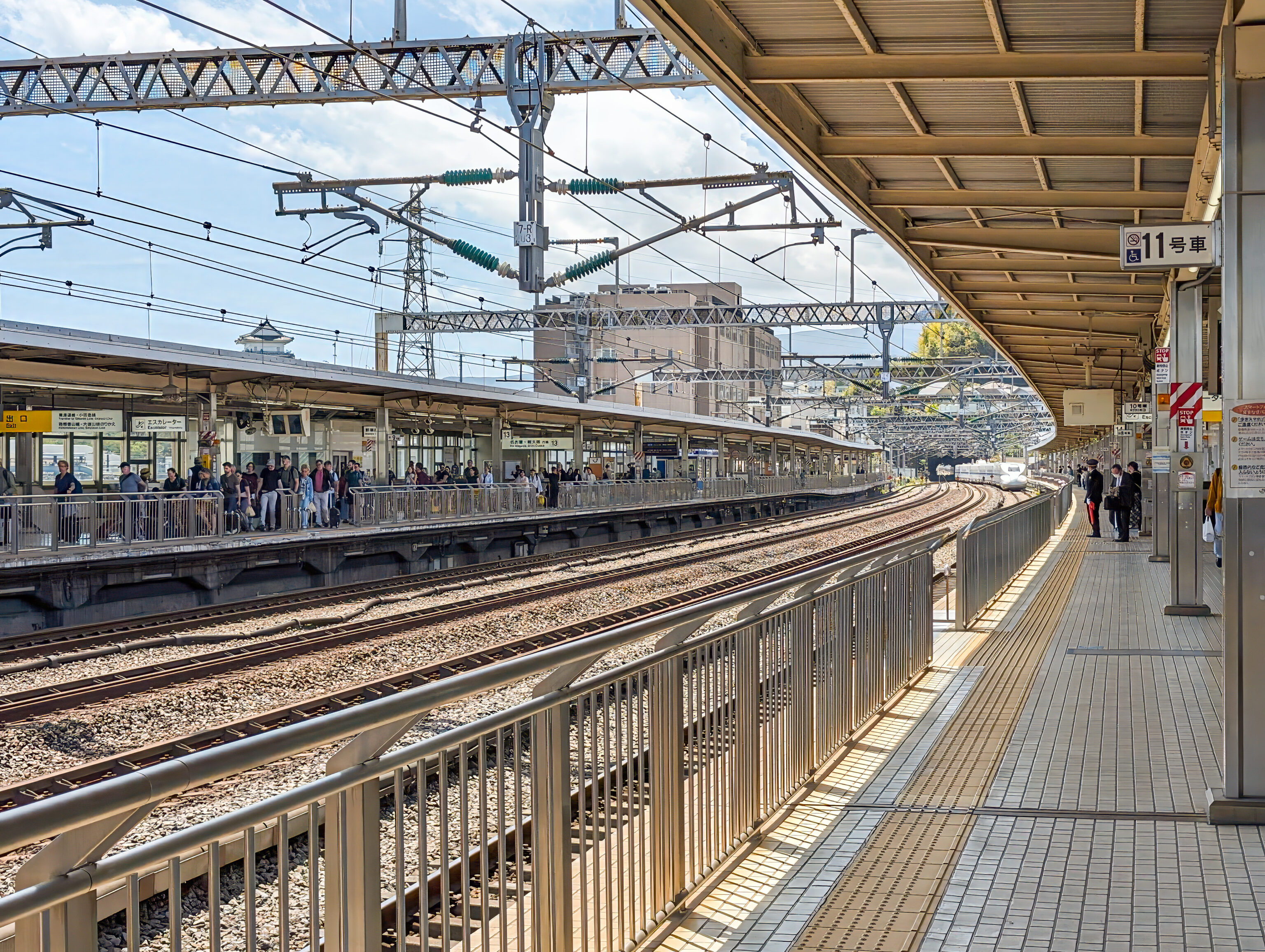
After our snack, we returned to Odawara Station to get our bags and catch the Shinkansen back to 品川駅 Shinagawa Station in Tokyo.
Haneda
After arriving at Shinagawa, we took the 京急本線 Keikyu Line to 羽田空港 Haneda Airport.
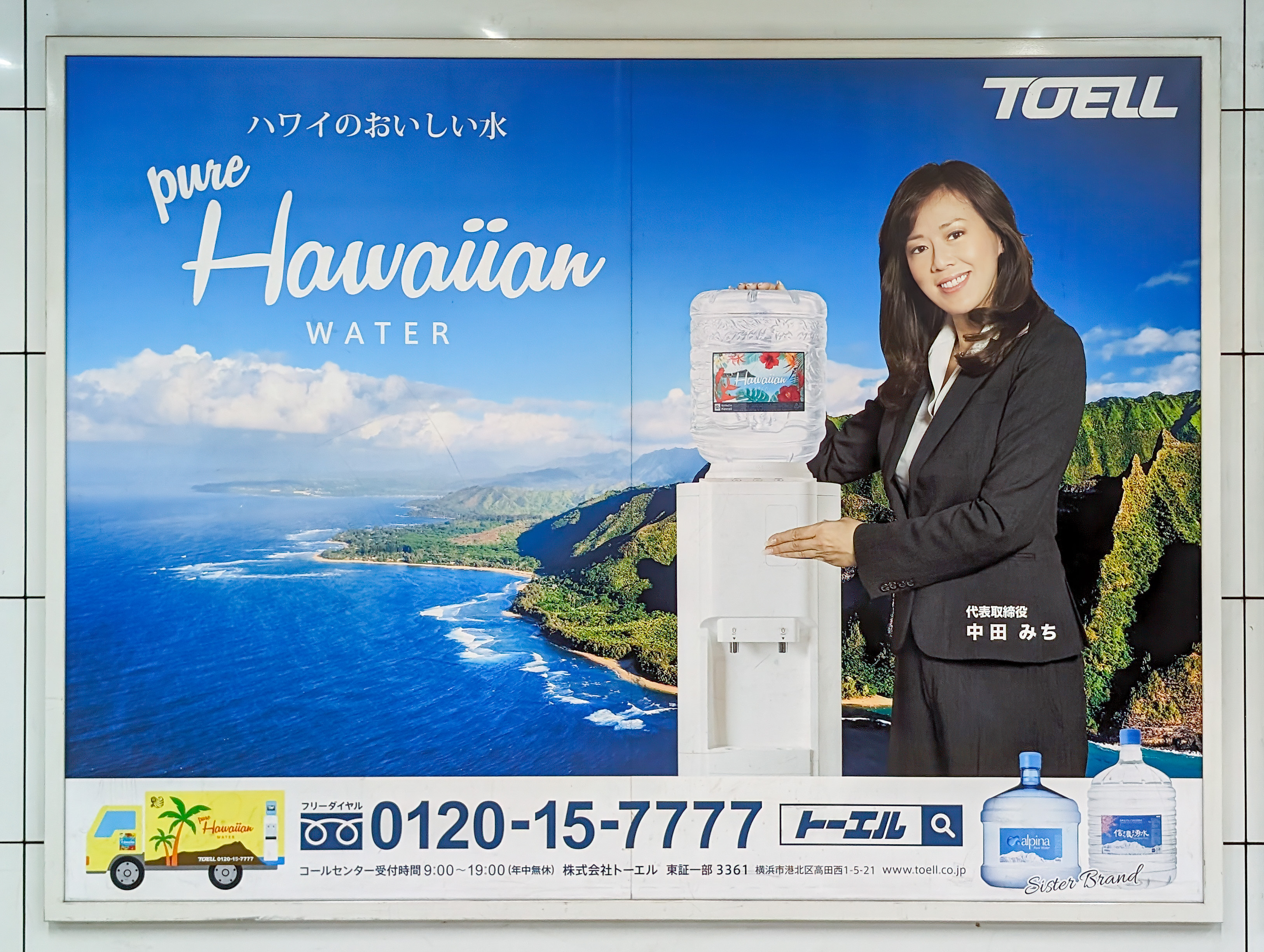
We were amused by this sign at the airport advertising Hawaiian water! After getting off the train, we went upstairs to check in and went right to the ANA Lounge afterwards.
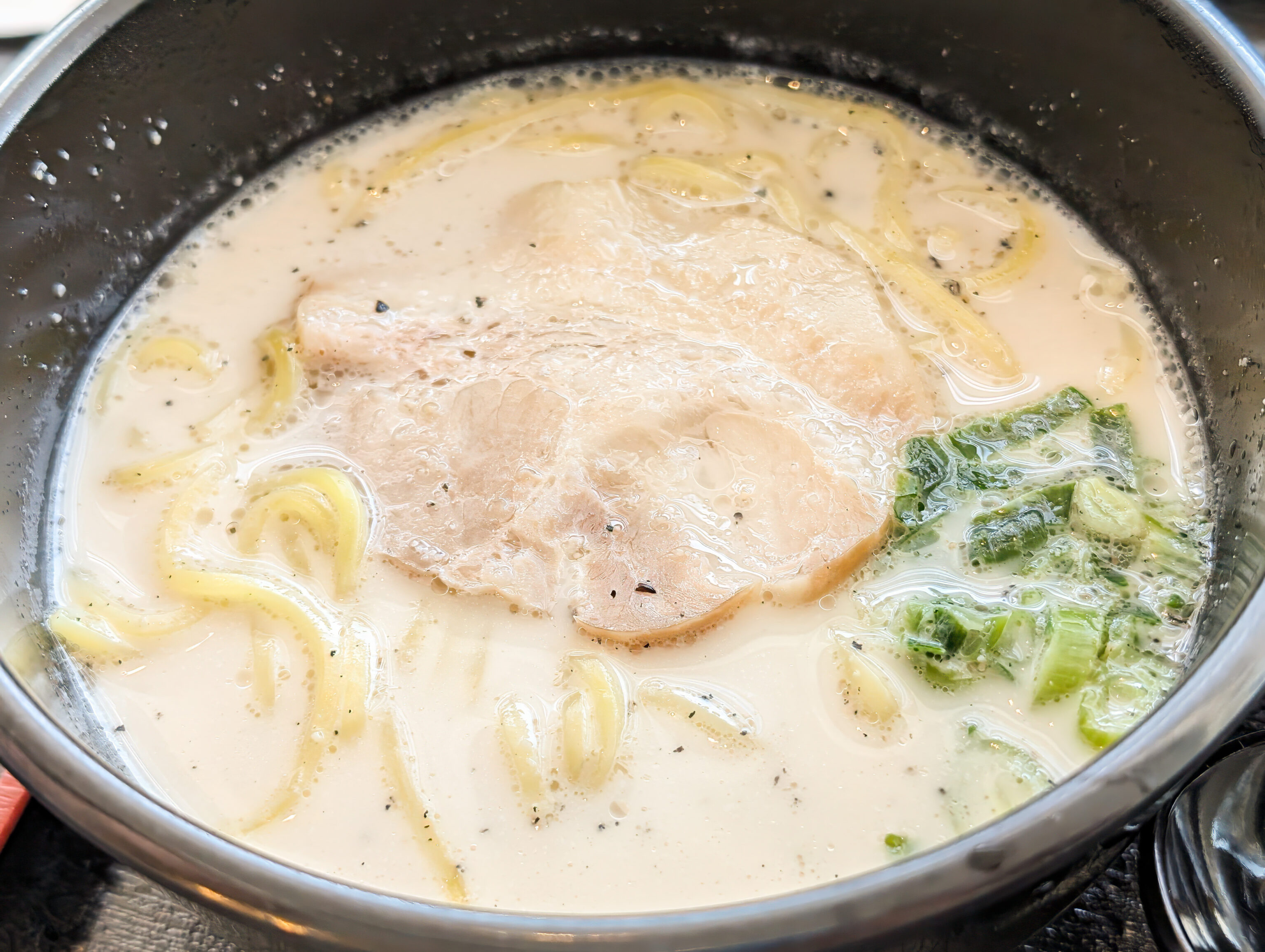
The highlight of the ANA Lounge is the noodle bar. There are a few options to choose from but this time we just had the ramen. It’s certainly isn’t the best ramen in Japan but it is still much better than 99.9% of ramen available in the US! A completely made up metric here of course!
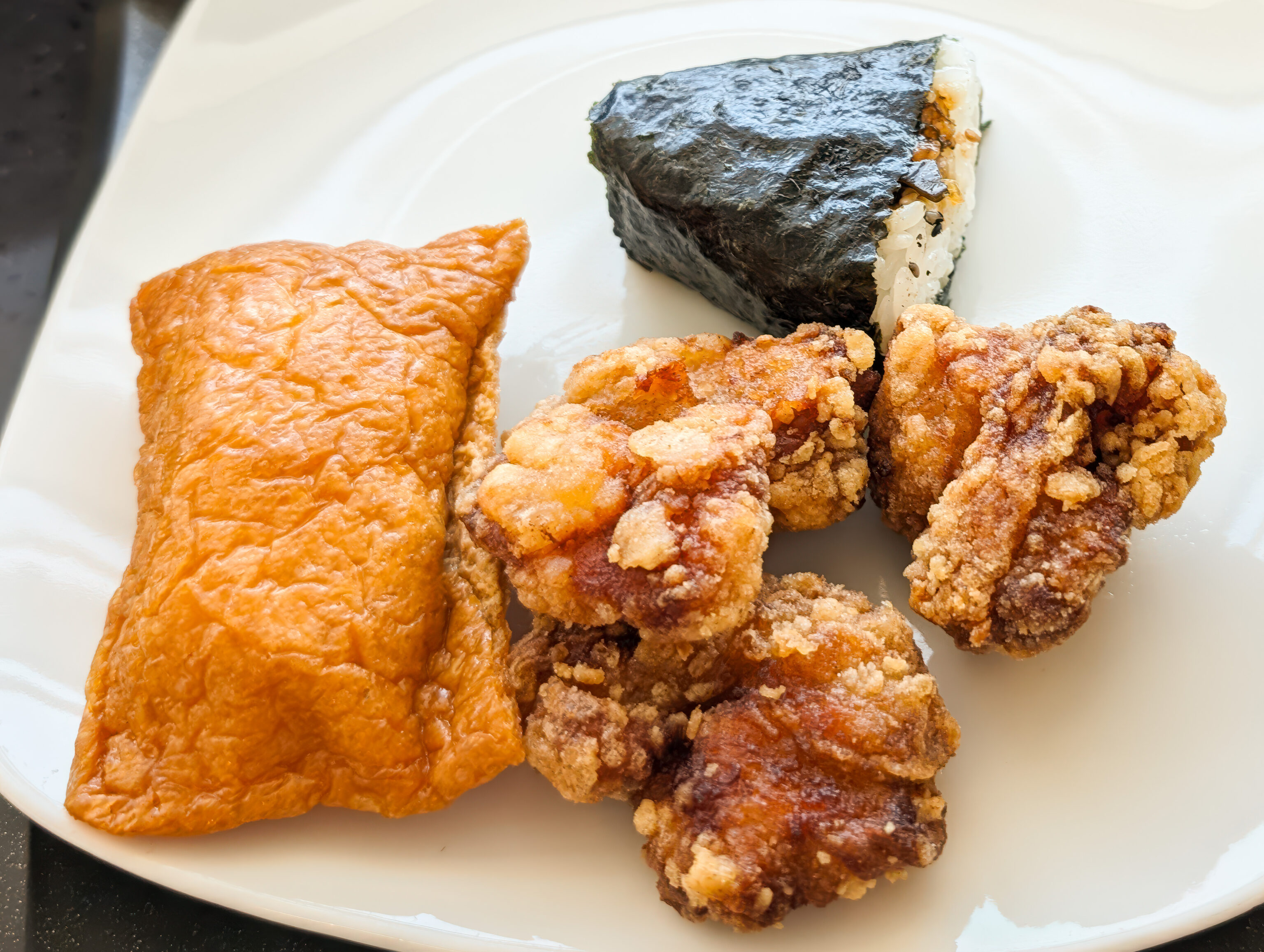
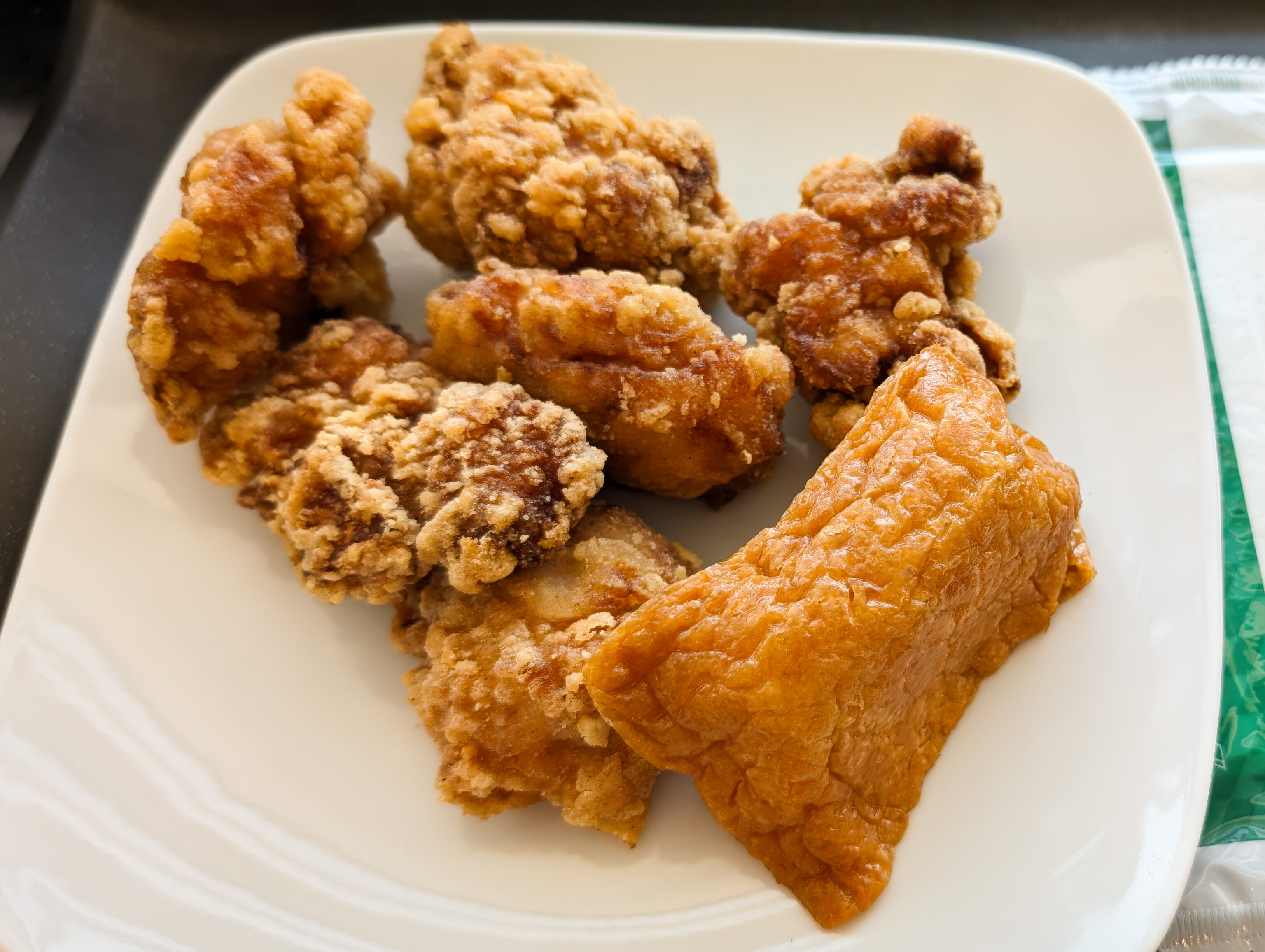
We also snacked on some of their other offerings. The karaage is quite far from the best in Japan but still nice to eat! It’s much better than American fast food chicken. The inarizushi is also a decent snack, along with the onigiri. 7-Eleven’s onigiri are much better though!
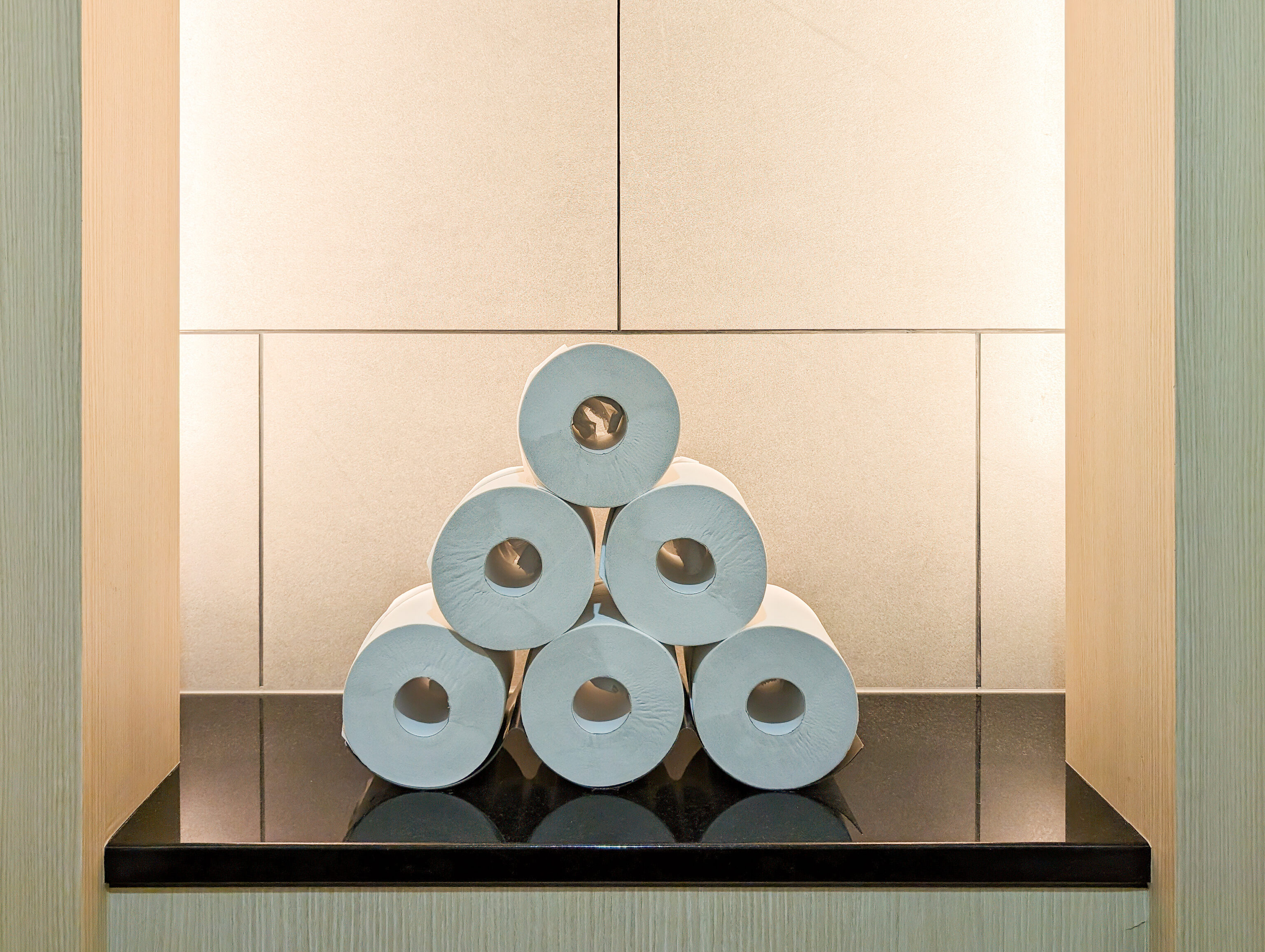
In Japan, even extra toilet paper can be beautiful!
Soon though, it was time to board and bid farewell to Japan. Until next time!
- Wikipedia – Mister Donut: https://en.wikipedia.org/wiki/Mister_Donut ↩︎


